I would love to tell you that what follows is an accurate, factual account of the history of the sea sprite boats, and that I poured over old company records, boat registrations at the State, etc. to be able to compile a list of all the boats that were constructed and who bought them.
NOT!!
Here is a fun story told through the brochures of the manufacturers of the Sprites. The Sea Sprites started in the 1960’s being built by firms that started and collapsed, ending with the closing of CERyder in the late 1980’s. I dug out these old brochures from my old SSA files to piece together the story, and I have added at the end a Forum thread from 2007 that is a vaguely recalled oral history that adds to the story. If you, the reader, can add to the story, I would be happy to include your thoughts.
THE SS23 STORY
Hope Valley, circa. early 1960’s. Deep in the southwest part of RI a fiberglass constructor names Herman Wyss made a mold and began building SS23’s. The boat was called a Sea Sprite Cruiser, and for all the world sounds like the Weekender. It had 4 finished bunks, an ice box, sink, water tank, and a marine head. Here is a listing for the Cruiser dated 1966:
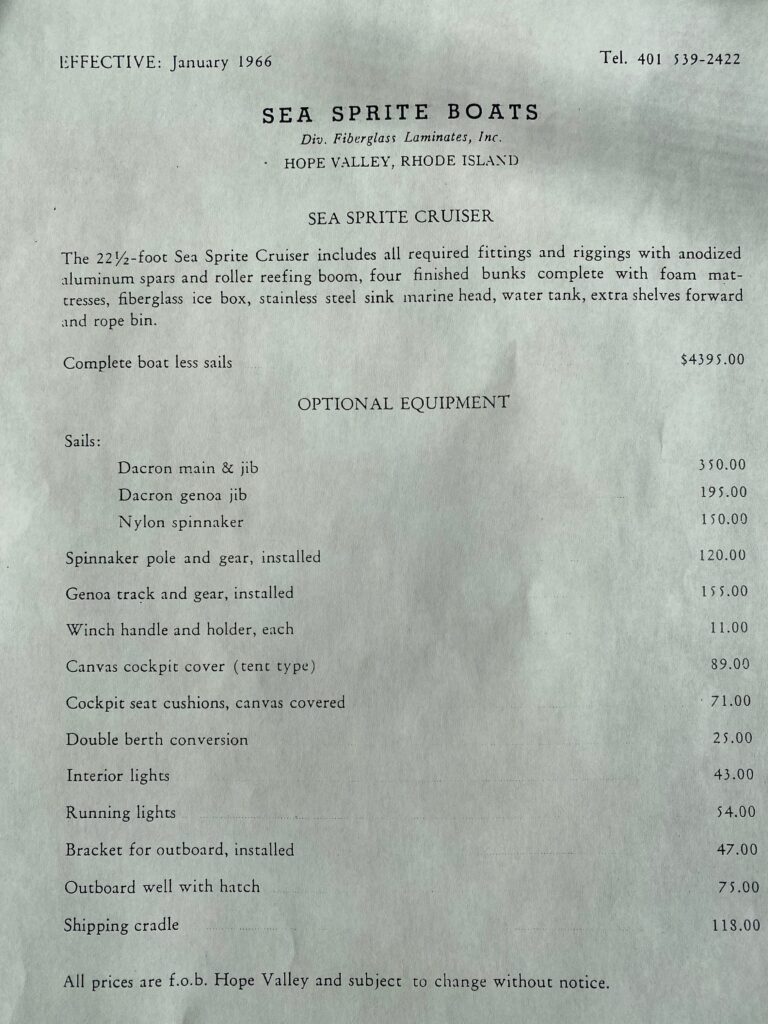
Below is a copy of Mr. Wyss’s obituary from the Providence Journal dated dated March 12, 1999:
Herman Wyss, Jr, 81 , of Hopkinton, Rhode Island , owner and operator of a fiberglass business in Hope Valley, R.I. for 20 years died Friday at Kent County Memorial Hospital. He was the husband of the late Hazel (Maynard) Wyss.
Born in Georgia, a son of the late Herman Sr. and Stephanie (Tyszkiewicz), he had been a resident of Exeter before moving to Hopkinton 20 years ago. He aslo owned a Hope Valley boat building business and built the Sea Sprite. He was an Army veteran of World War II, retiring as a lieutenant colonel.
He leaves 3 sons, Robert, Thomas and William Wyss, all of Rhode Island; a step daughter, Deborah Bailey of Wakefield; a brother, Raymond Wyss of Forster, RI; a sister, Lucy Masciarelli of Hendersonville, NC; and a step-grandson, Wayne bailey of saunderstown, RI. He was the brother of the lateJ. Arthur Wyss.
Somewhere around the mid-60’s a boat builder called Sailstar, located in West Warwick, began production of the sea sprite Day Sailor. It is the Day Sailor we know today. Here is a SailStar brochure listing both the Cruiser and the Day Sail. Apparently both Sea Sprite Boats (Wyss) in Hope Valley and Sail Star were marketing the Cruiser, but Sailstar had recruited Carl Alberg (see page 2 of the following brochure) to “modify the popular SS to convert her into a roomy and comfortable day sailor”. Thus the Day Sailor is born.
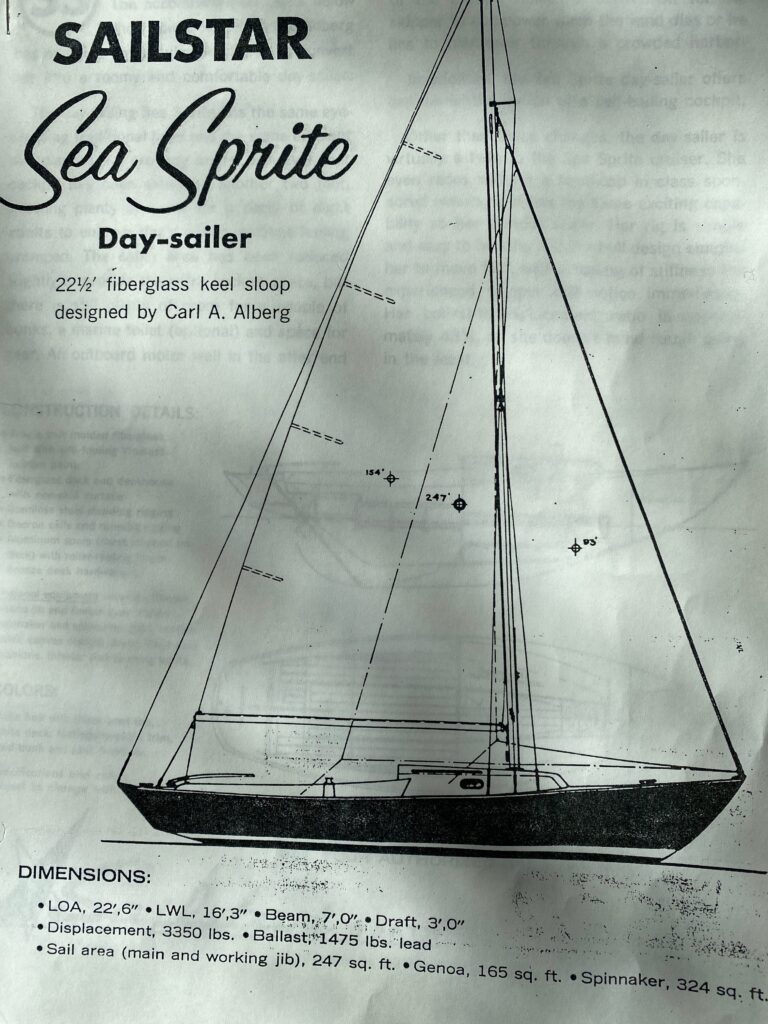
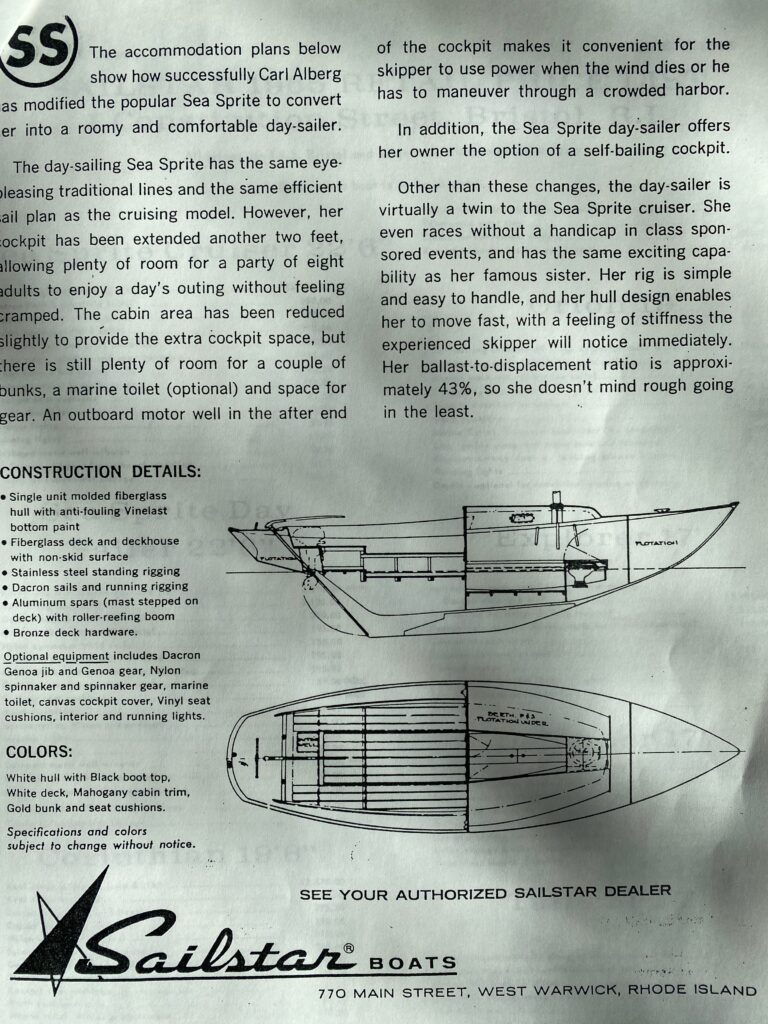
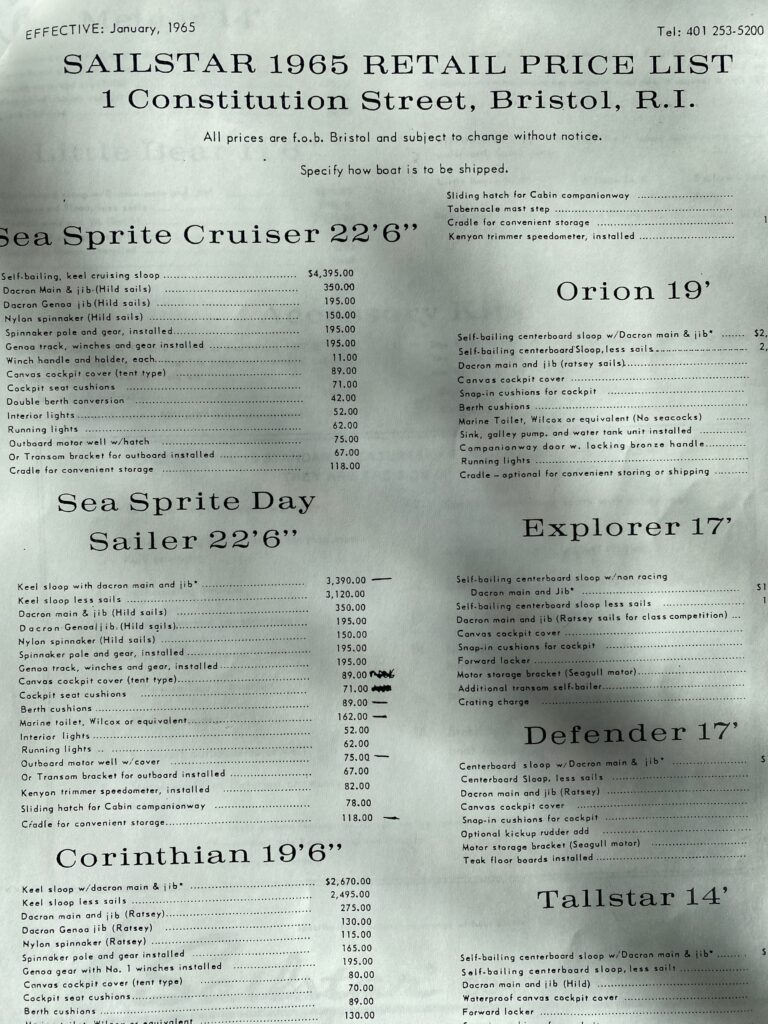
Boat builders came and went in those days. Clint Pearson bought out SailStar in 1964. By 1970 a company on Oak Hill Rd in North Kingston named Sea Sprites, Inc. was producing only the Day Sailor. Here is their 1970 price listing:
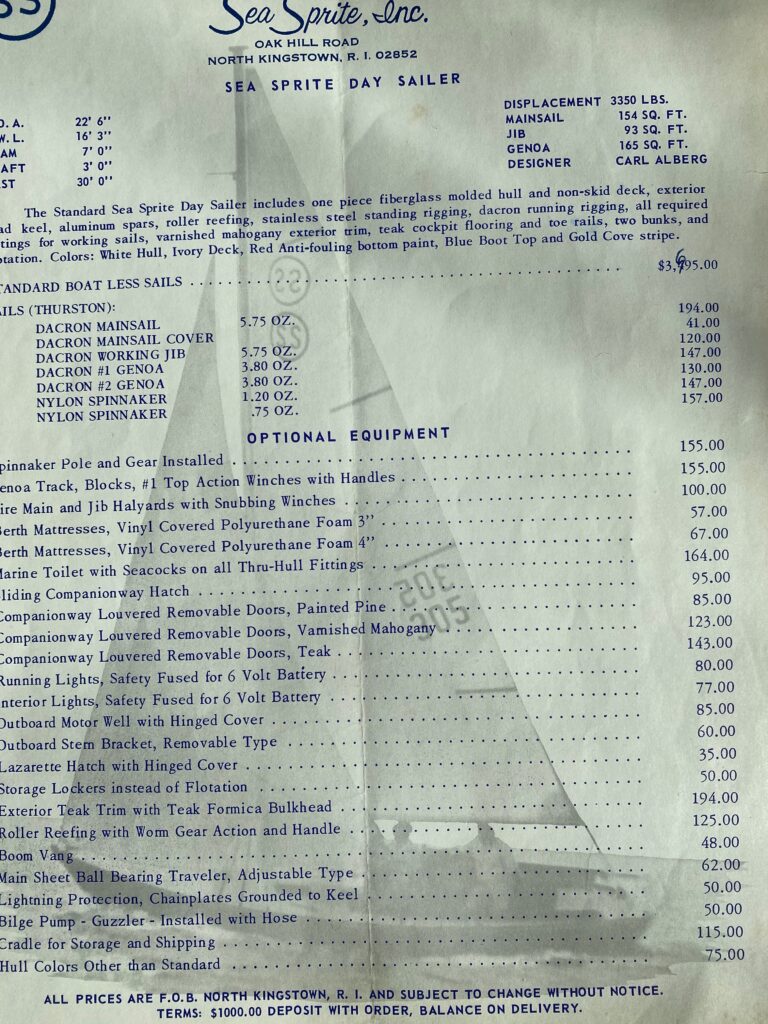
One year later, in 1971, Sea Sprite Inc. has moved to Wickford Shipyard who offered not only the day sailor but once again the racer cruiser!! Check out the next 2 brochures. The first describes the Cruiser…
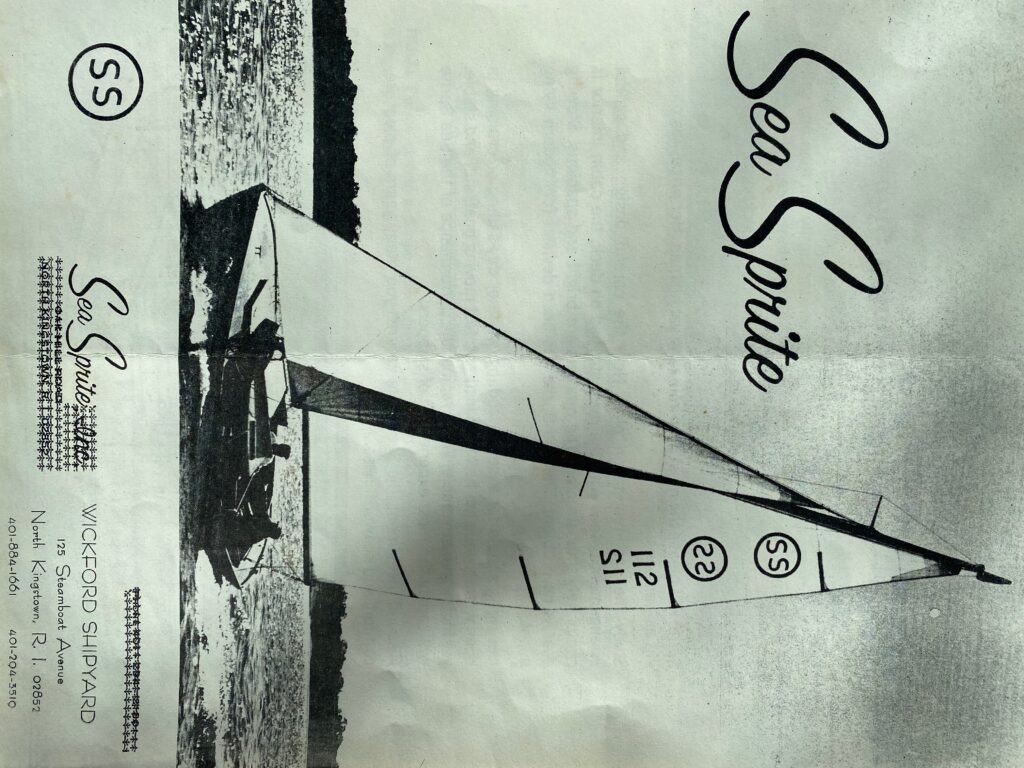
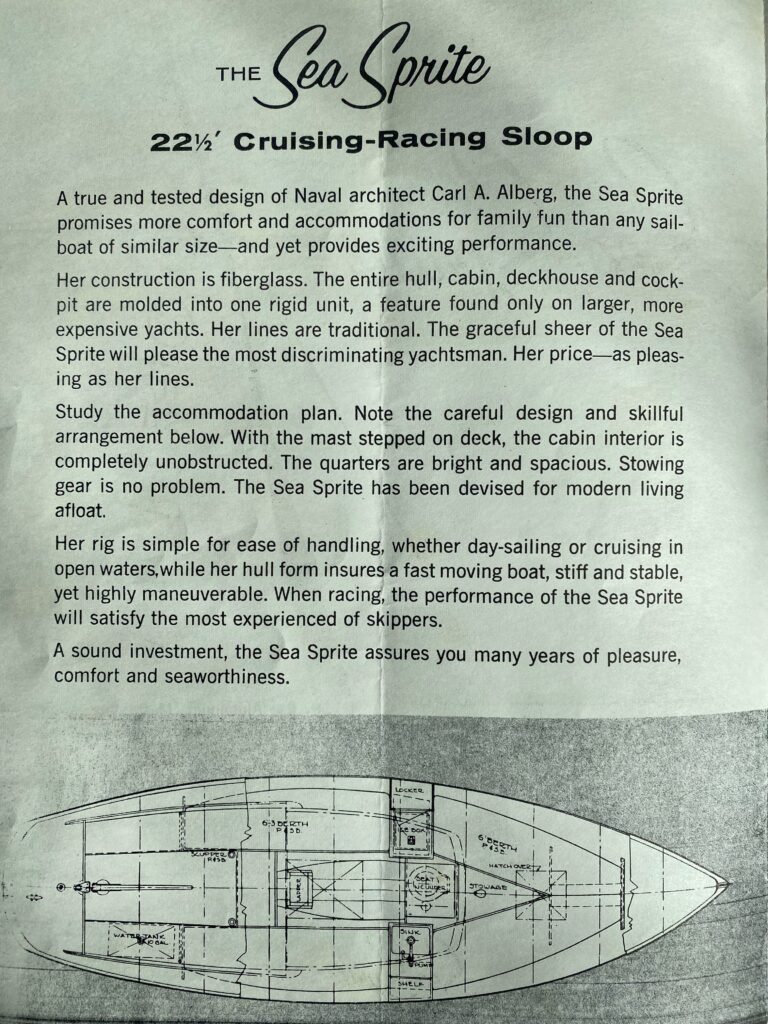
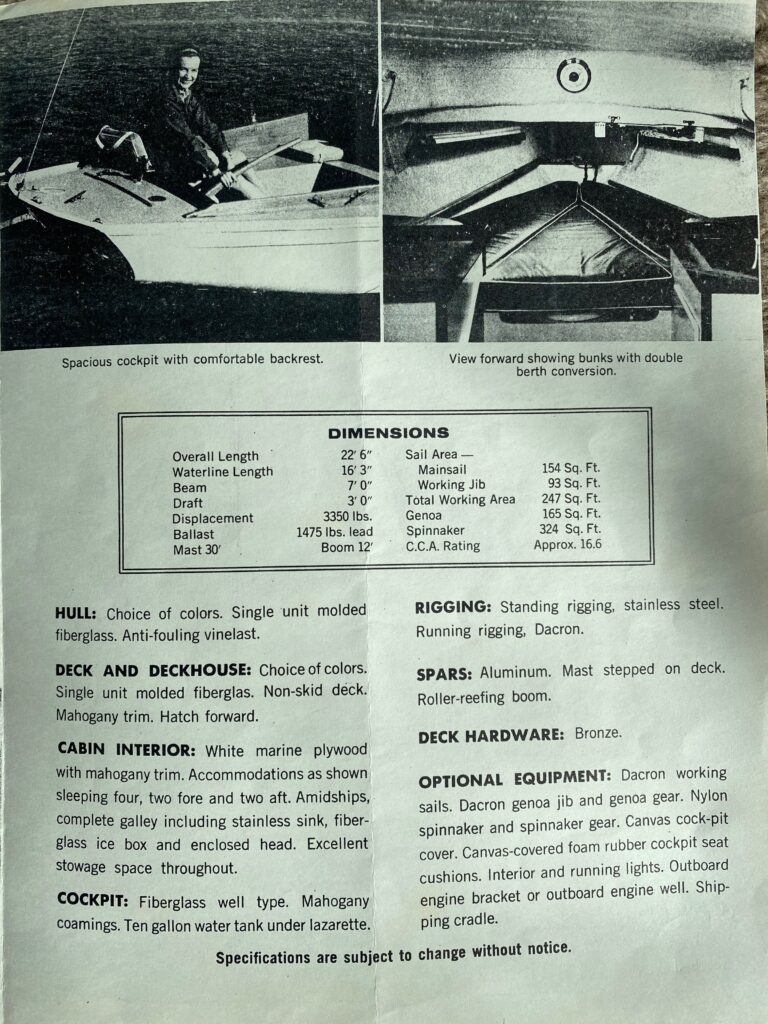
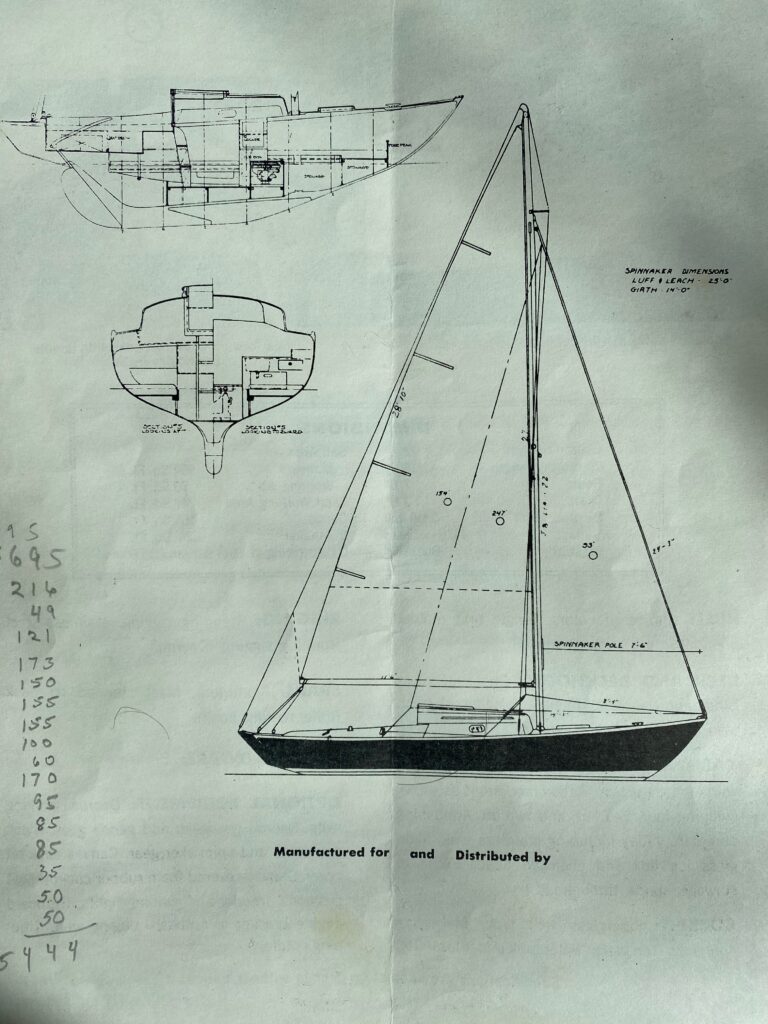
And the second brochure describes the Day Sailor…
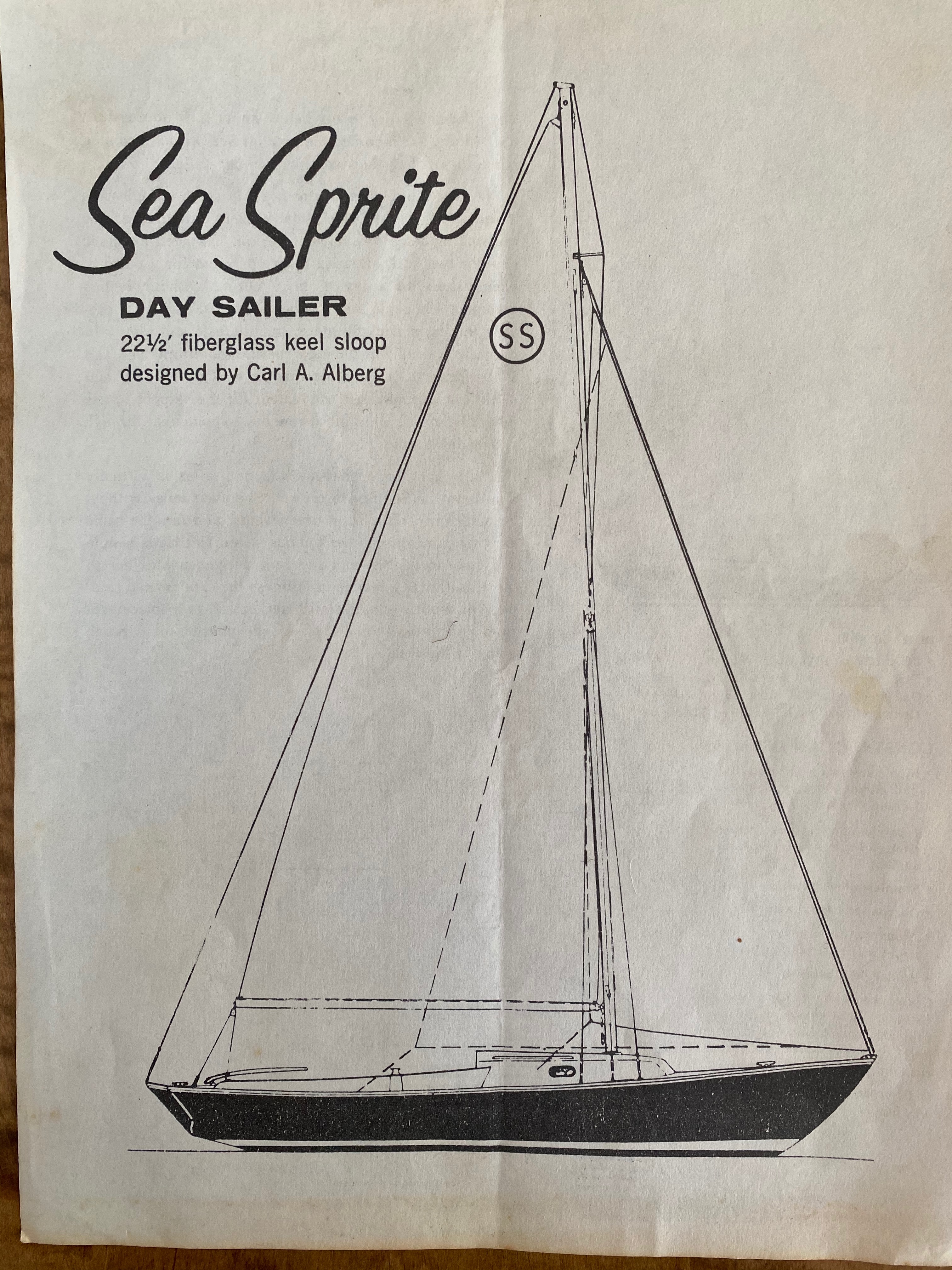
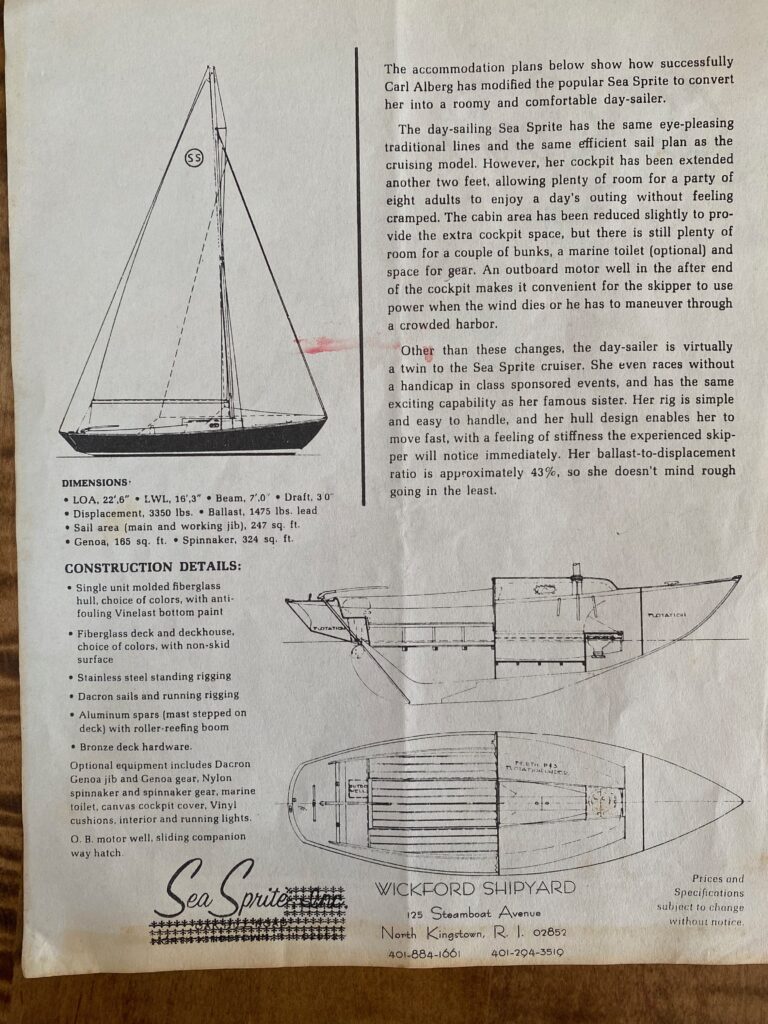
By 1979 CERyder, Corp, in Bristol, RI, was the sole builder of sea sprites. He manufactured only the SS23 cruiser/racer but with a number of changes. The lead keel was fully encapsulated with fiberglass and integrated to the hull. The interior had a full liner, and portholes were bronze. A diesel engine was optional. The boats had to be ordered, and were manufactured at the Gooding Avenue plant in Bristol, RI, and were constructed side-by-each with their bigger brethren the SS27/30/34’s.
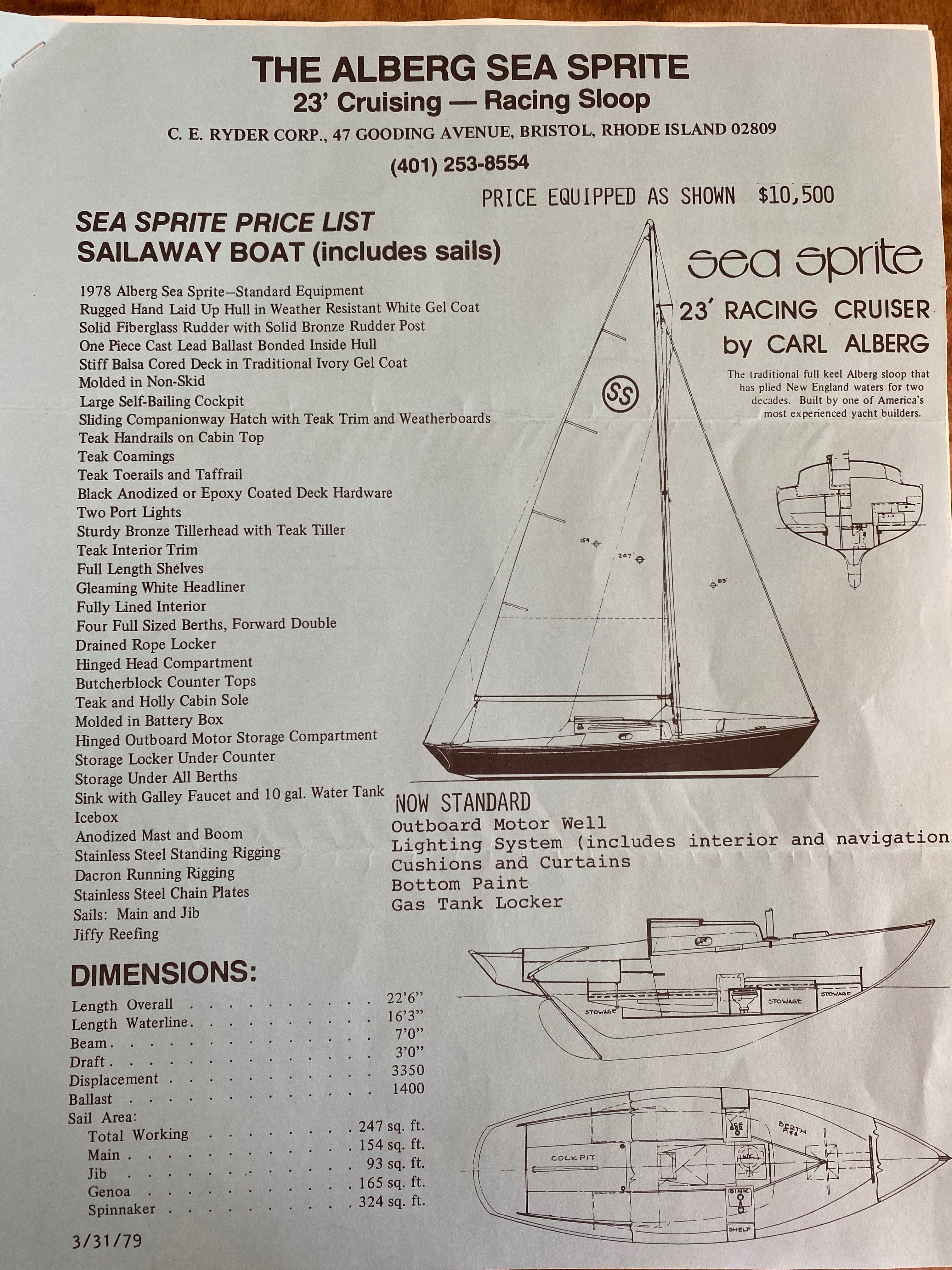
A price list from 1981 shows a diesel engine “ready to run” as optional:
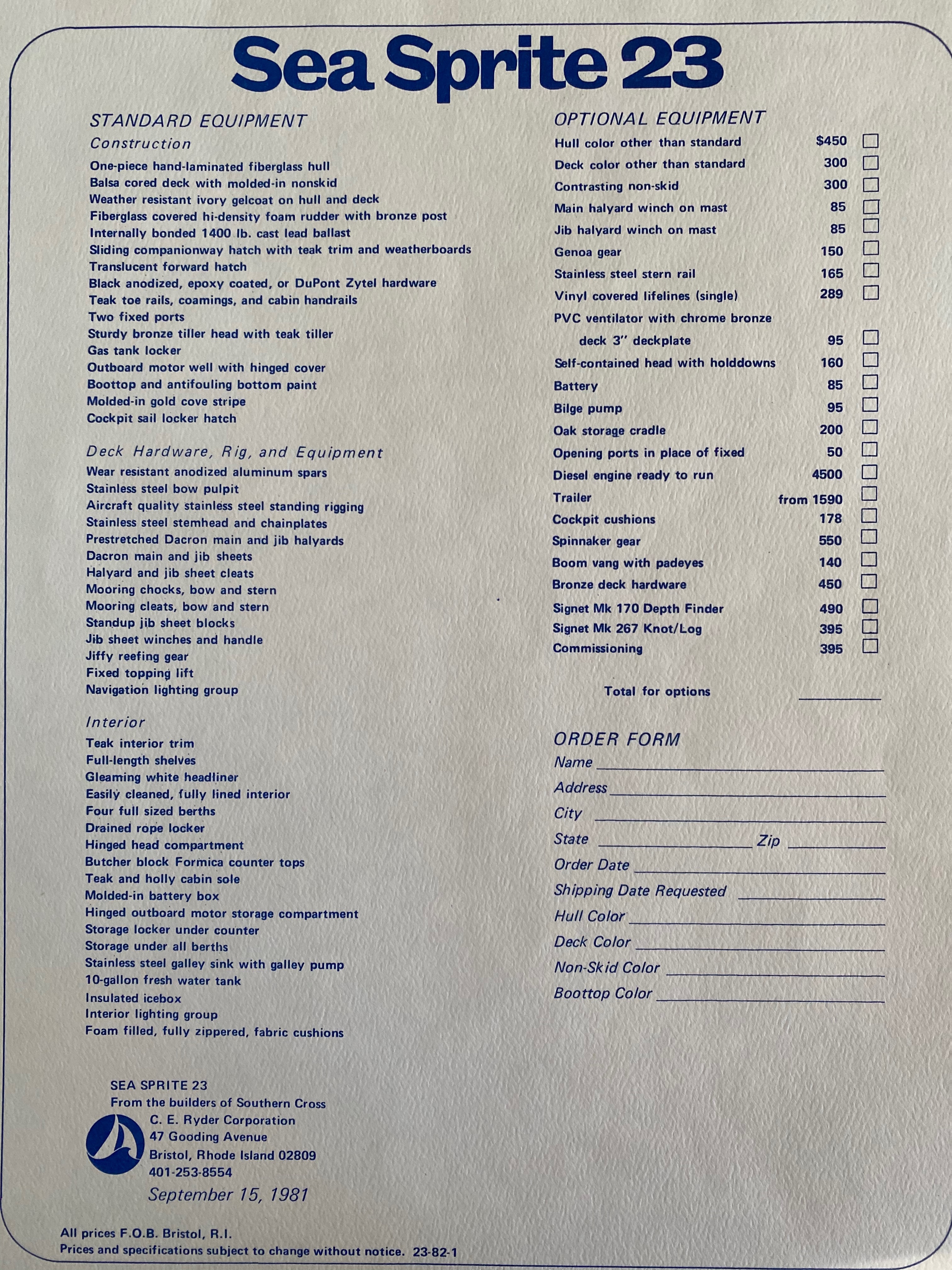
The classic Ryder brochure:

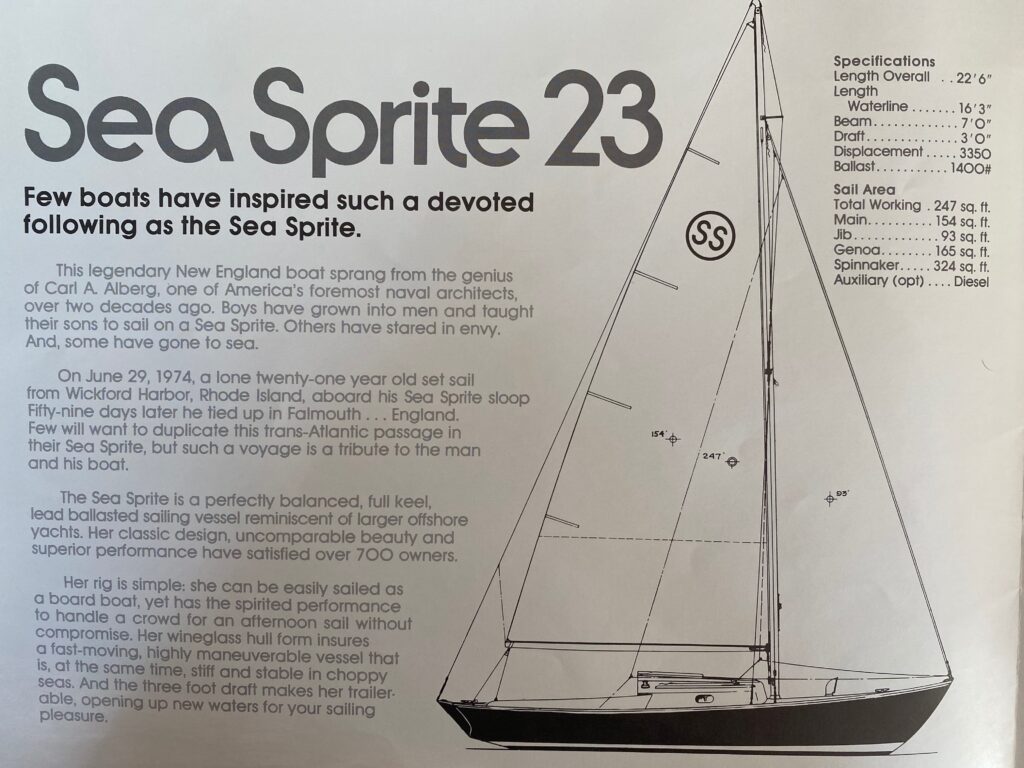
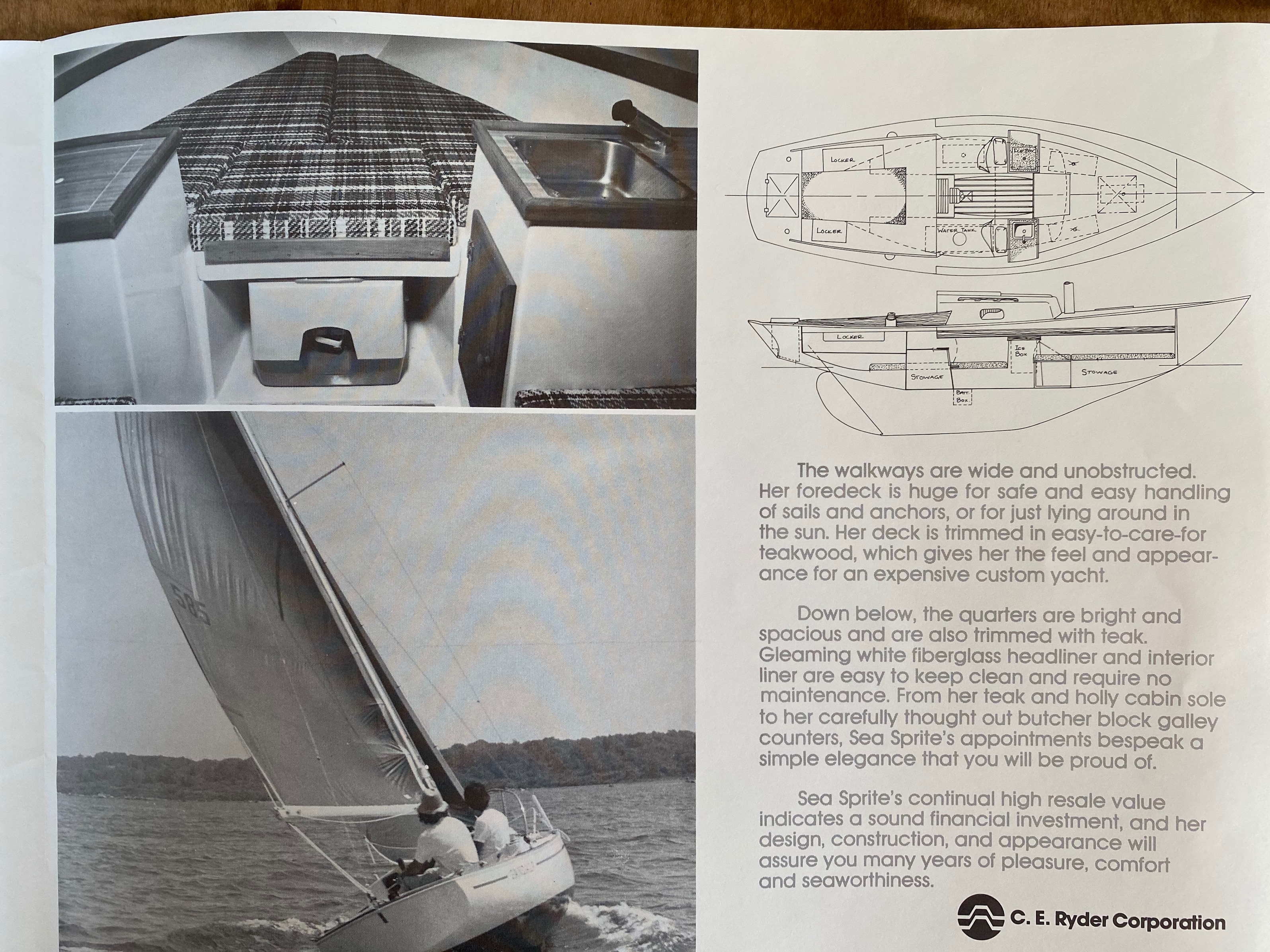
THE SS27/30/34 STORY
At the same time Ryder began constructing the Weekender, he began building the Luder-designed sisterships of the SS23. The boats were all built to order at the Gooding Avenue facility in Bristol, RI, side-by-each. The 27 and the 34 enjoyed a good run until Ryder closed up in the late 80’s. The 30, less popular (folks wanted wither a bigger or a lesser boat), sold about 20 boats.
Here is the brochure describing the entire line:
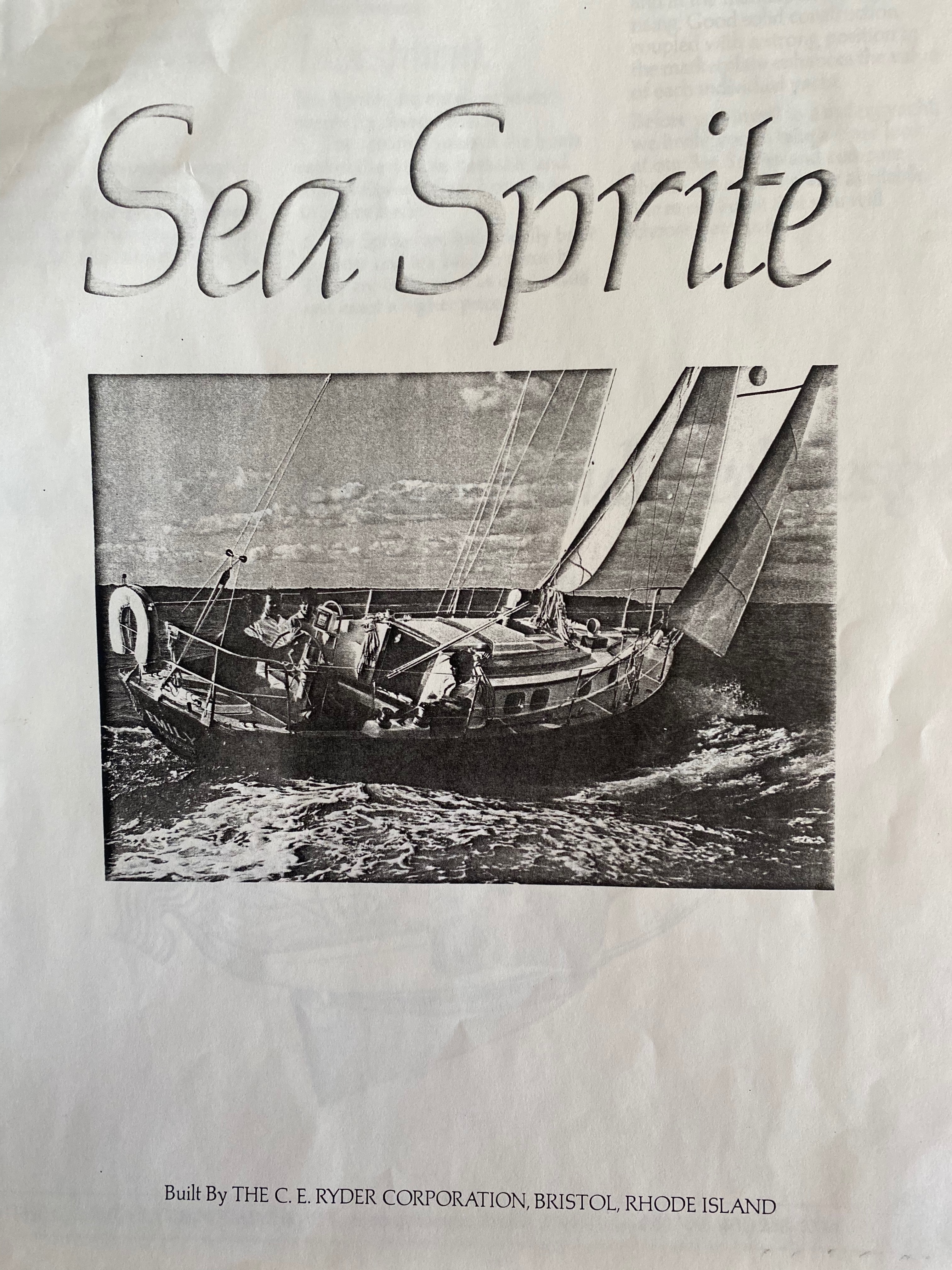
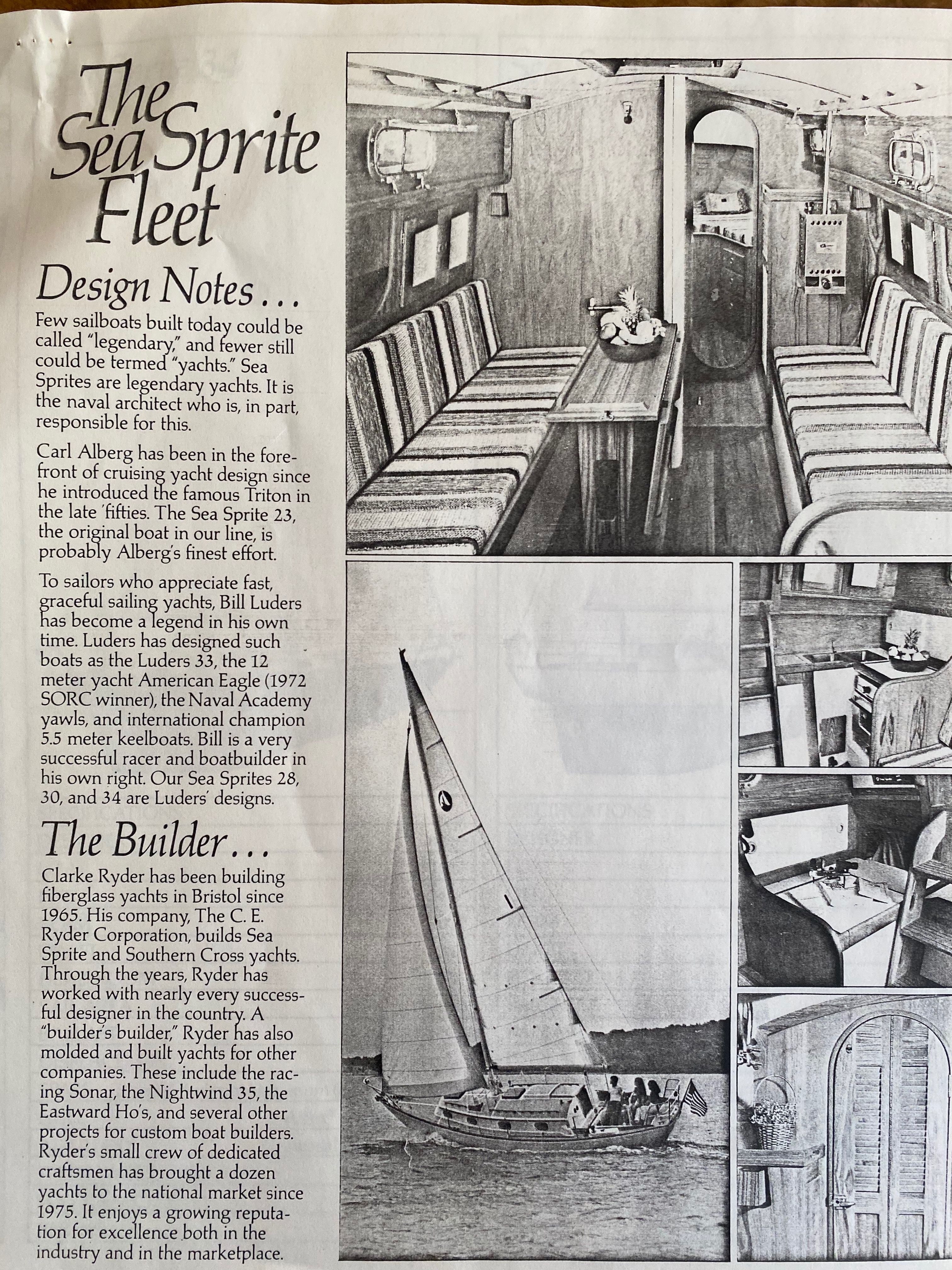
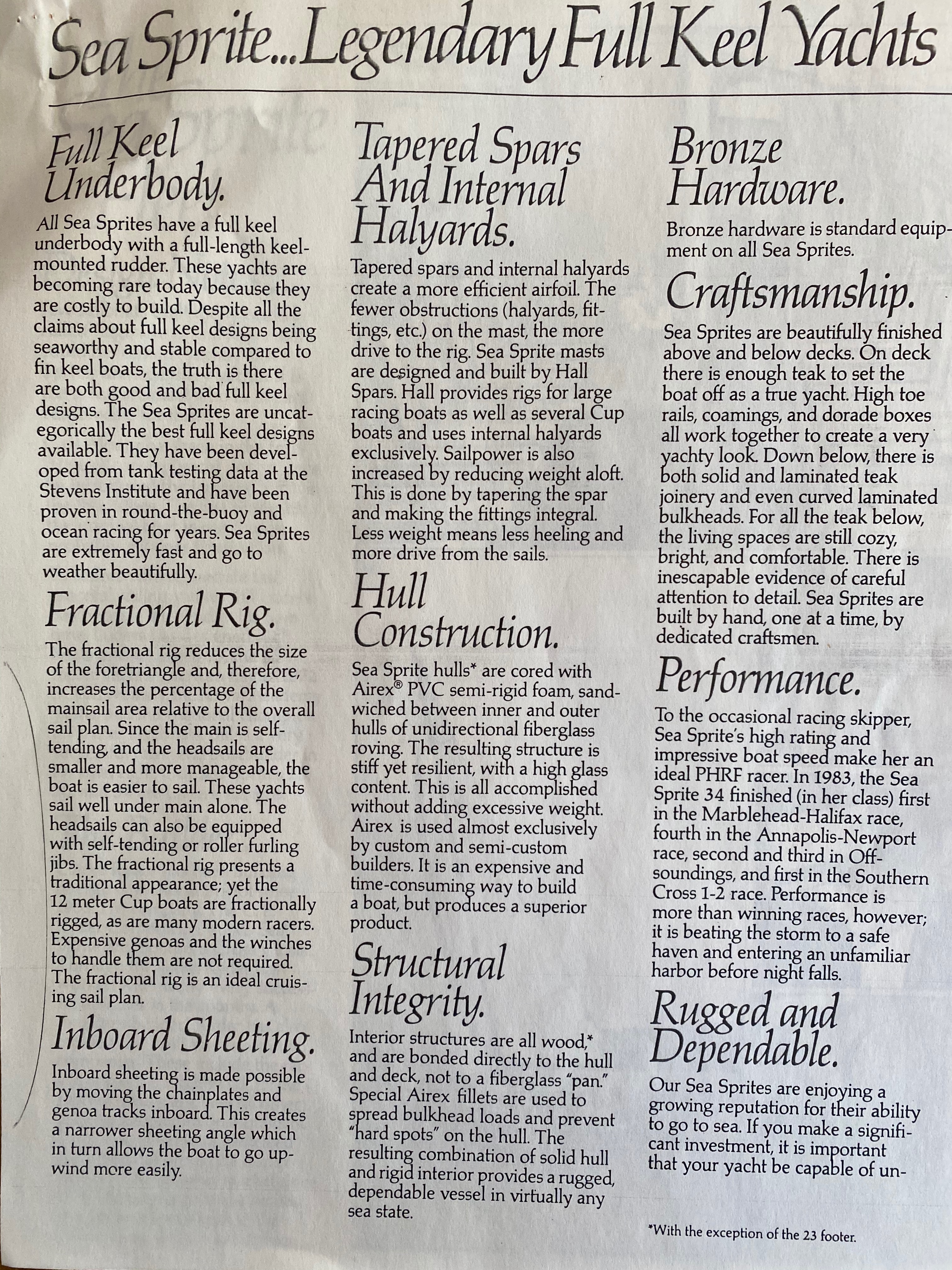
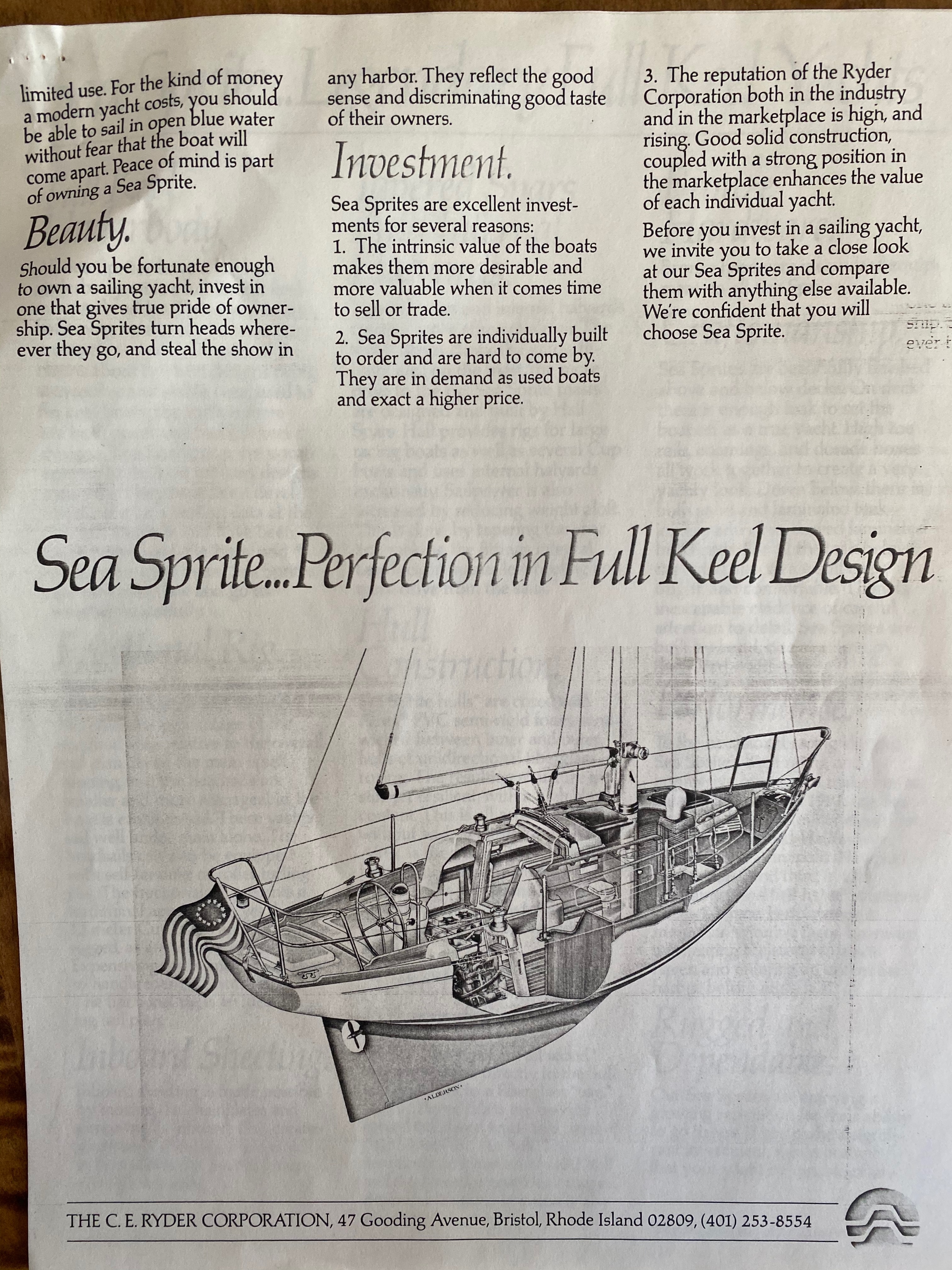
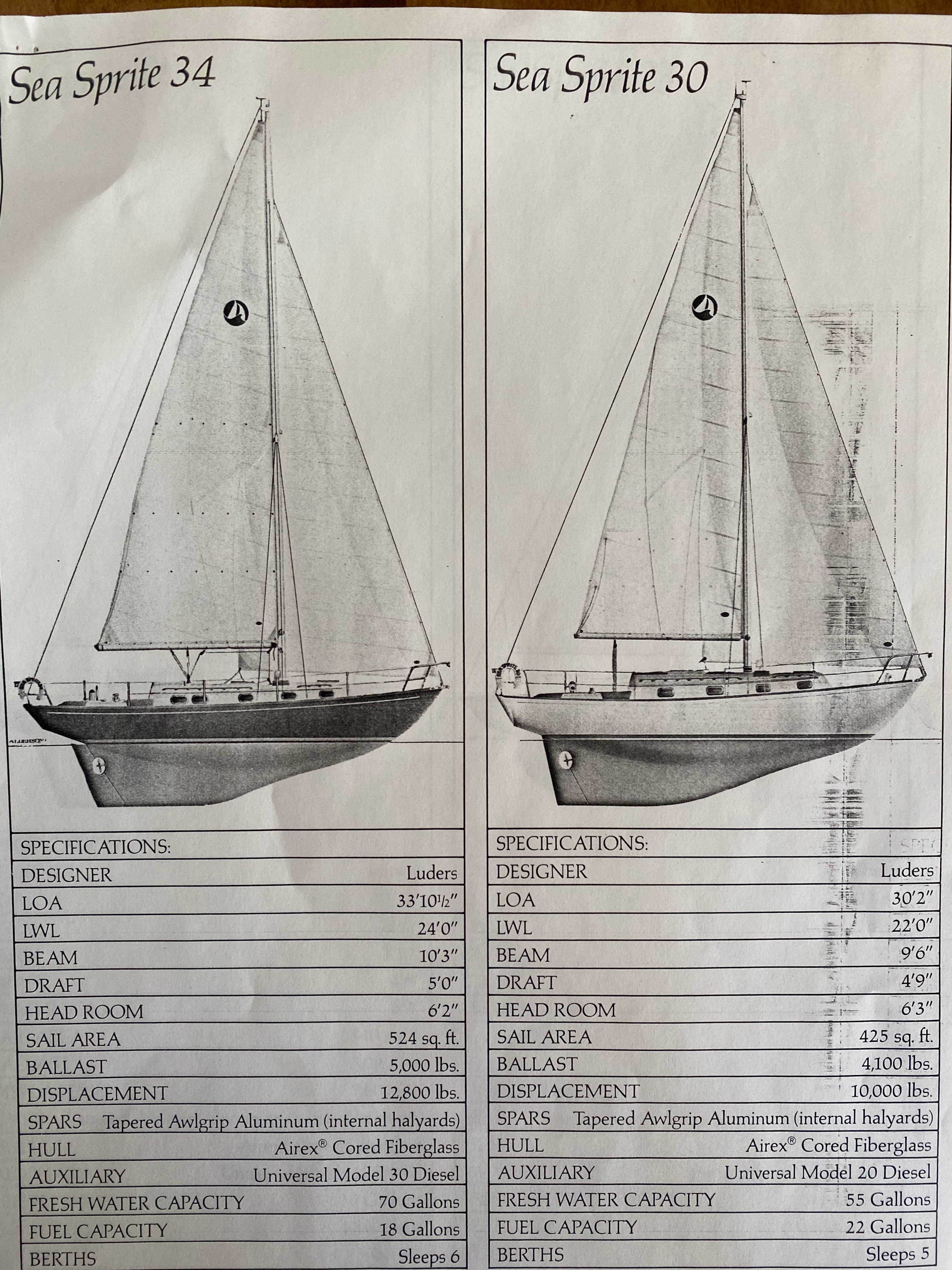
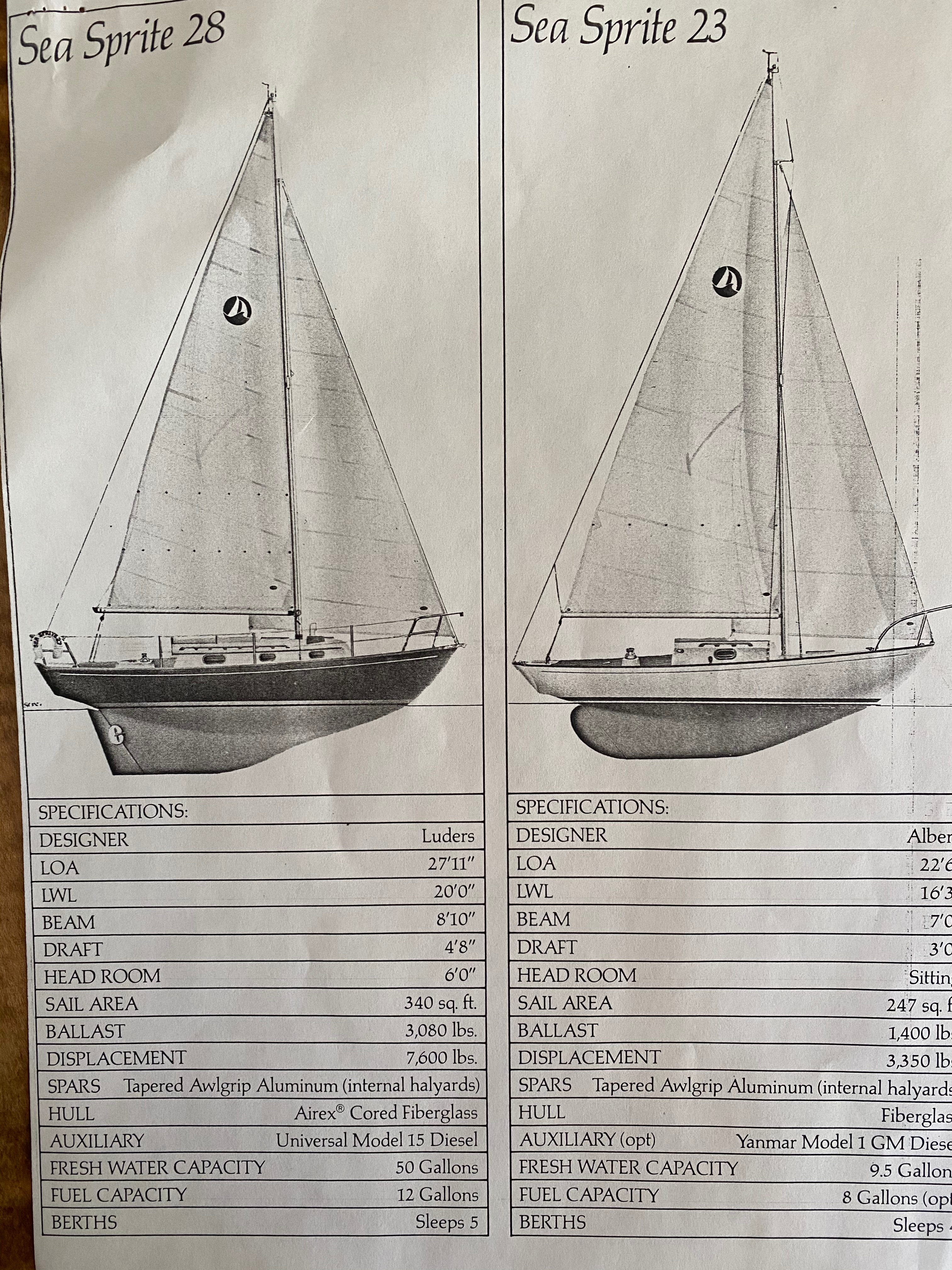
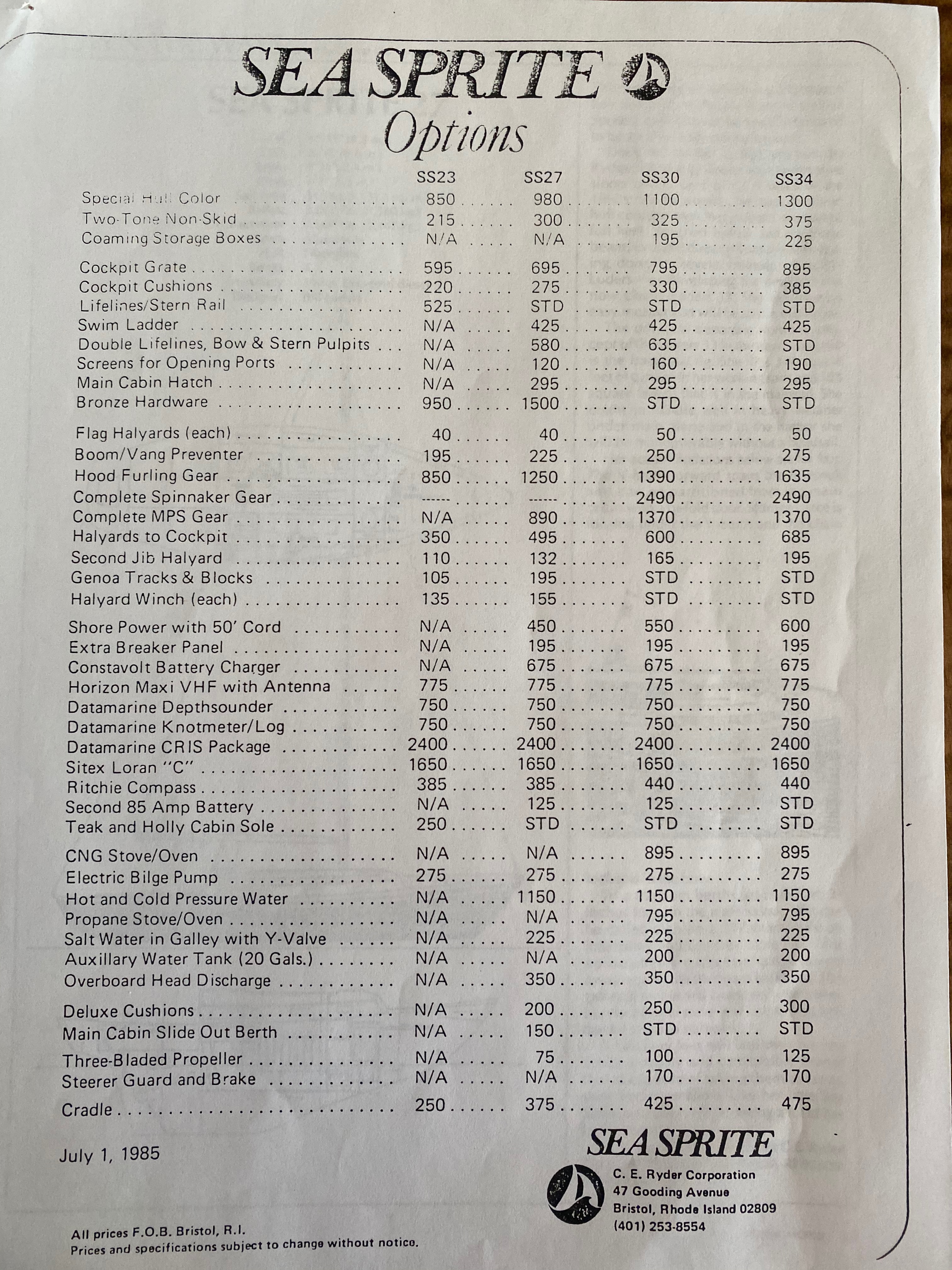
Here is a specific brochure for the Sea Sprite 27:
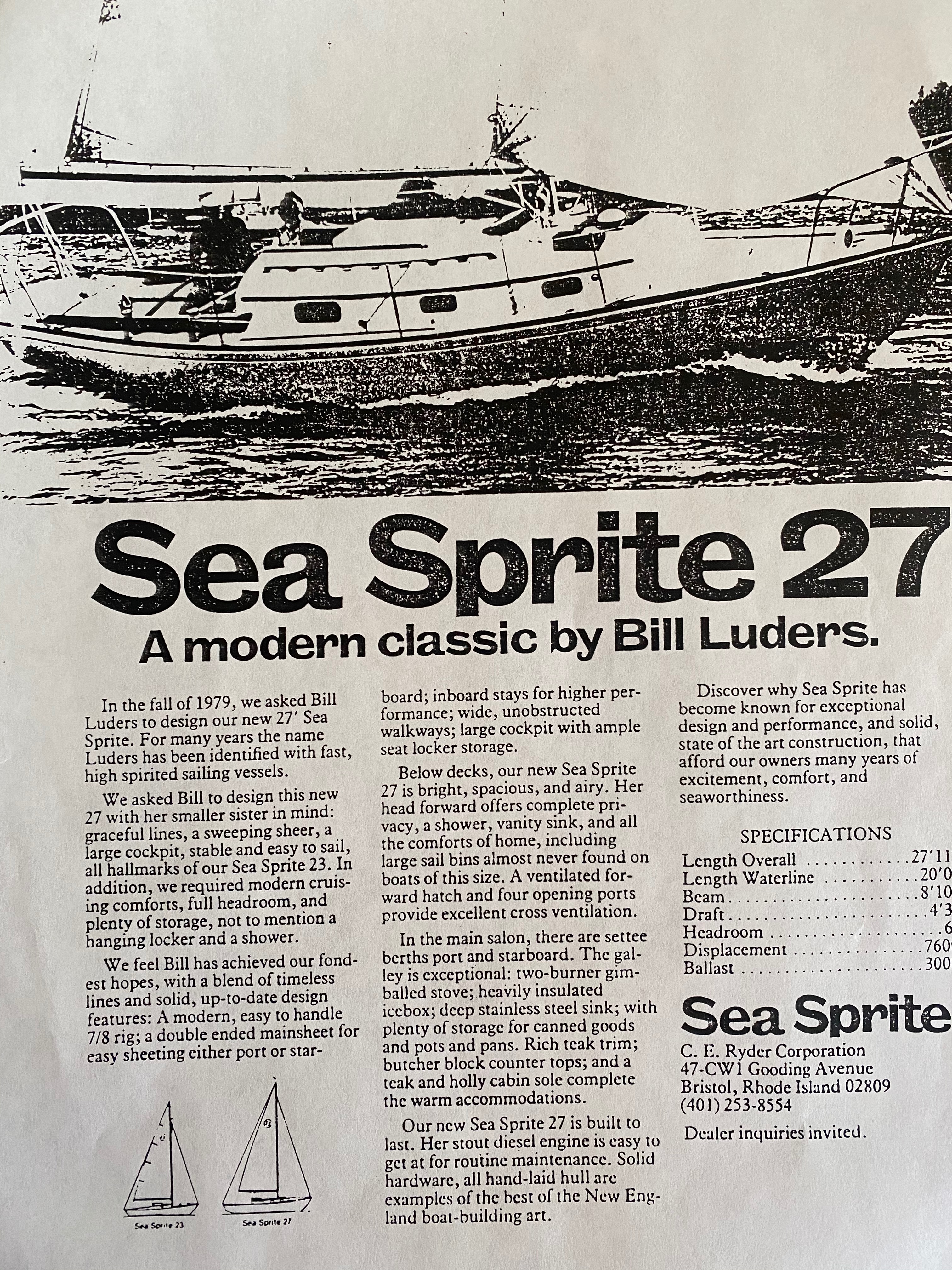
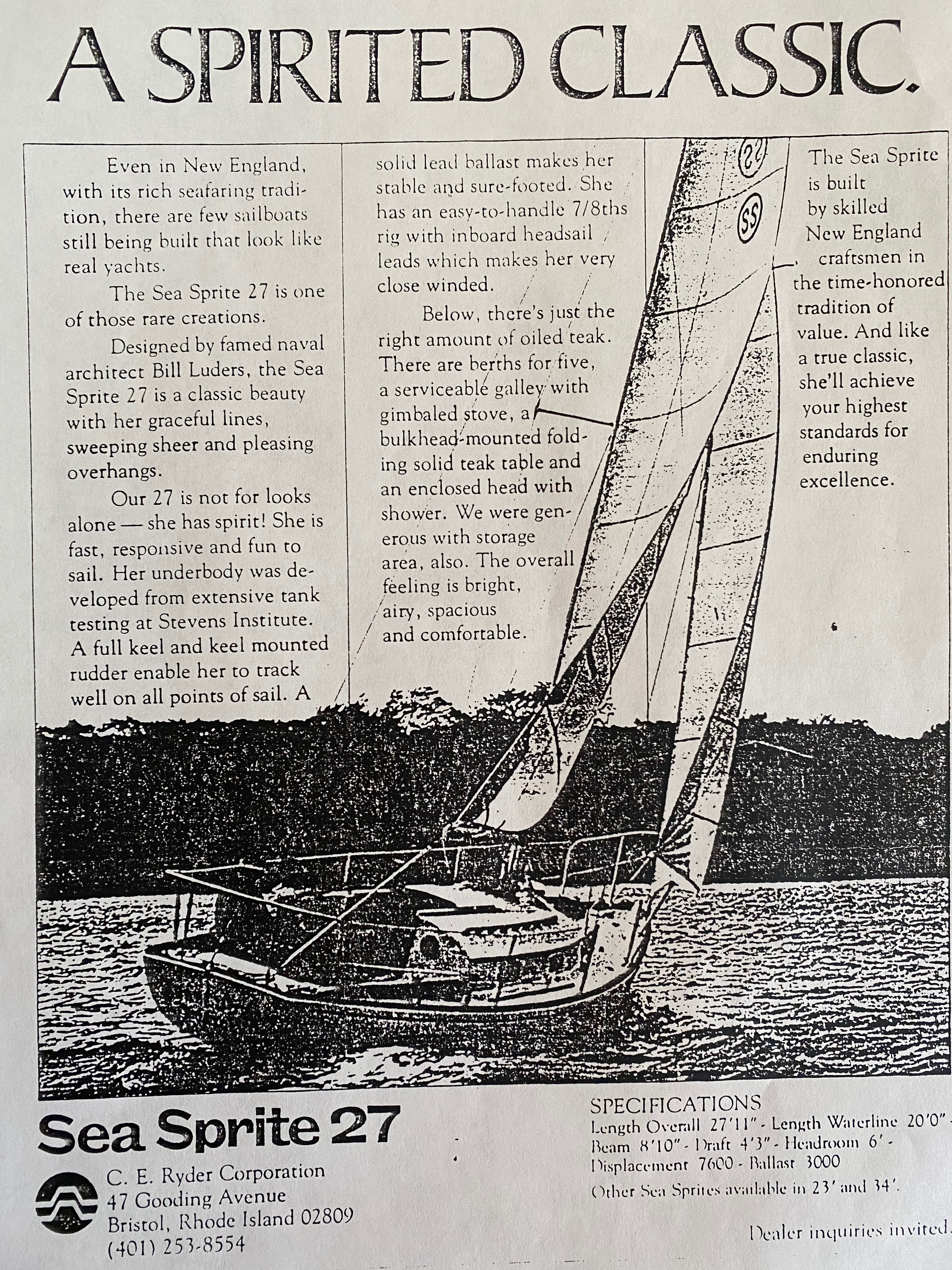
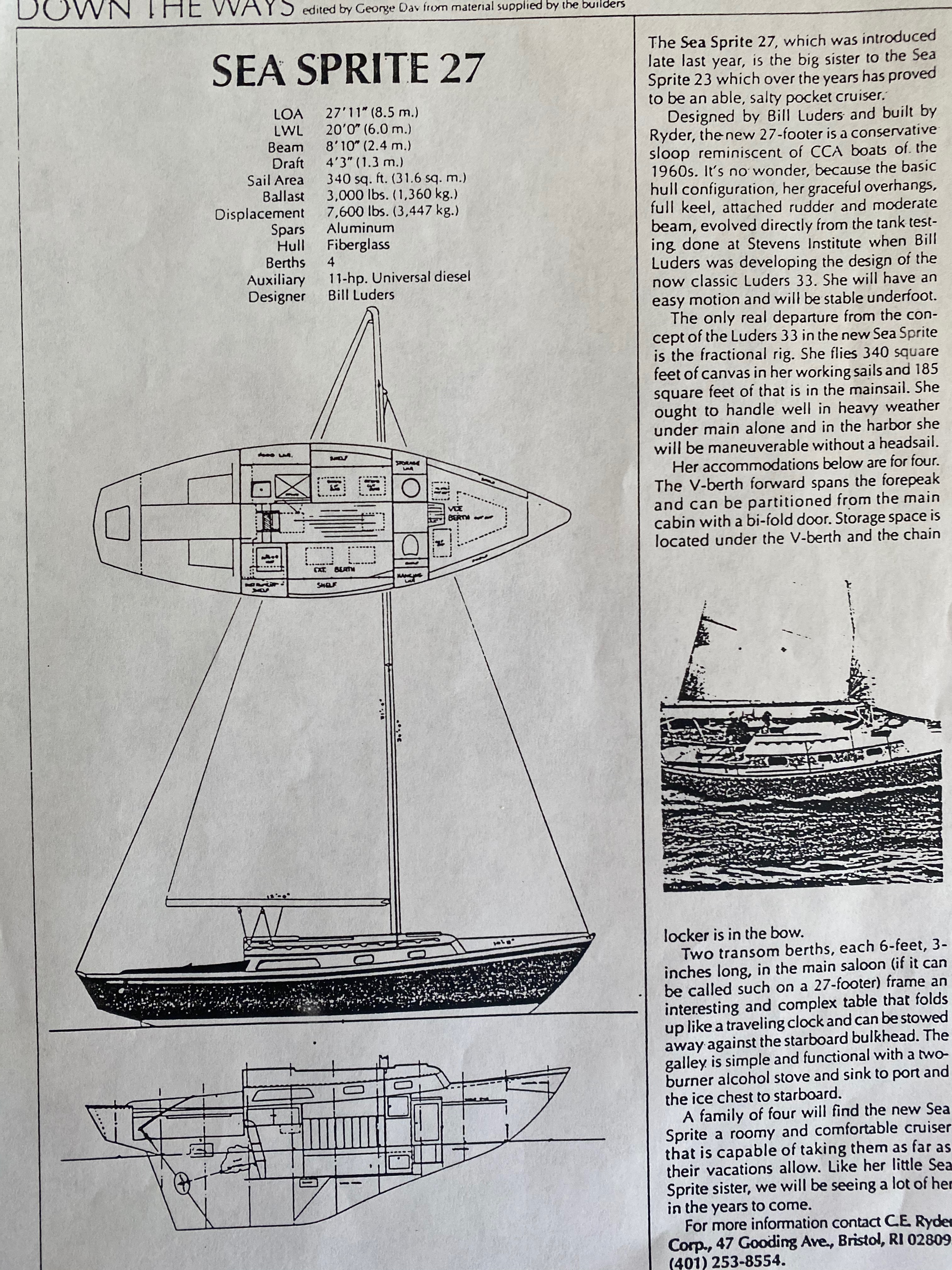
Here is an article from Spinsheet describing the SS30. I do not have a brochure for the boat, but I think the article is thorough:
The Sea Sprite 30, built by Rhode Island’s C. E. Ryder Co., may be easily overlooked by sailors unfamiliar with the model or the builder, but this small cruiser offers traditional style, good cruising accommodations for her size, well above-average quality, and perhaps a bargain price.
Many sailors are more familiar with Ryder’s Gilmer-designed Southern Cross series of double-ended cruisers introduced at the 1975 Annapolis Sailboat Show than with their Sea Sprite series. Actually, Ryder began building its Sea Sprite series a year earlier when it took over production of the Carl Alberg-designed Sea Sprite 23 in 1974. Following the success of the Sea Sprite 23, the 28-foot, 30-foot, and 34-foot models were subsequently introduced, and all remained in production until 1986.
Although sometimes confused on the water with similar Alberg-designed Cape Dory models, the Sea Sprite 28, 30, and 34 models were all designed by Alfred “Bill” Luders (1909-1999). The Sea Sprite 30 shares nearly identical overall and waterline lengths with the Cape Dory 30. However, she has a slightly higher freeboard, is six inches wider, and is most easily distinguished by her 7/8 fractional rig as compared to Cape Dory’s masthead cutter rig. I suspect some Cape Dory owners will argue, but I believe another distinguishing factor is that the Sea Sprite 30 is a step above the Cape Dory in quality of construction.
Unique for a production boatbuilder of the early 1980s, Sea Sprite hulls are constructed with Airex, a PVC foam core between inner and outer laminates of fiberglass cloth and polyester resin. The result is a stiff, yet strong and relatively light hull. The deck is also a cored composite built with a Balsa rather than Airex core for its superior properties in this application. The interior structures are all wood with no fiberglass pans or liners for structural support.
Several construction features I feel set the Sea Sprite 30 apart from her competition include fillets at the attachment of bulkheads to spread the loads and prevent hard spots, bulkheads that are attached to both the hull and deck, a hull-to-deck joint that is bolted on six-inch centers, and stainless steel chainplates bolted to structural members that better distribute rigging loads.
On deck, my favorite feature is the teak toe rail that is twice as large as those found on other boats of this size. If you don’t like it for its rugged looks alone, you’re sure to appreciate it the first time you ever have to make a headsail change in nasty weather. Teak handrails, cockpit combings, dorade boxes, and an “eyebrow” above the cabin ports all contribute to the traditional, yacht-like appearance, but do add to the maintenance chores. All bronze ports also add to the look, with the added advantage that they don’t wear out after 10 to 15 years of service.
The cockpit is comfortable, as wheel steering is standard equipment, and there is plenty of readily accessible storage in port and starboard seat lockers and a small lazarette.
Down below, the arrangement is simple and proven to work for more than 50 years. A V-berth cabin forward is followed by a port head and starboard hanging locker. There are mirror image settees in the main saloon and a galley aft separated by the companionway. Eight opening ports and two deck hatches provide good ventilation. And, with a displacement of 10,000 pounds, there is plenty of volume for good storage and 55 gallons of potable water in two tanks. An abundance of solid and laminated teak joinery is offset by light colors to avoid a dark interior.
Auxiliary power was provided by a freshwater-cooled, two-cylinder Universal Marine diesel engine which, at 3600 RPM, produces a rather anemic 11+ horsepower. This is adequate for most days on the Chesapeake Bay or coastal cruising, but a 10,000-pound boat needs 18 to 20 horsepower for severe conditions or serious bluewater cruising.
Luders is perhaps best regarded as a designer for his successful 5.5-meter racing sloops, so it stands to reason that he would know a thing or two about designing relatively heavy boats that sail well. It seems he did. With a displacement length ratio of 419 and a sail area/displacement ratio of 14.65, the Sea Sprite 30 was heavy even by early 1980s standards, but she has proven to be quite responsive even in light to moderate winds. Let it blow 15 knots or more, and the advantages of a 41-percent ballast/displacement ratio, a fractional rig, and a tapered mast become apparent in her stiff and stable performance. With a 22-foot waterline and rather long overhangs, she does tend to hobbyhorse in short choppy seas, and it becomes more important to keep excess weight out of the ends.
As of November 1, three Sea Sprite 30s were offered for sale at Yachtworld.com with an average asking price of $37,300, while the average of the last four reported sales was $35,700.
For comparison, the last four reported sales of early 1890s Cape Dory 30s averaged $31,750, and the last three reported sales of Morris Yacht’s 29 Annie model, from the same era, averaged $64,600. While I’ll admit that the Sea Sprite 30 doesn’t enjoy the same reputation of an Annie, and perhaps may not be quite up to the quality, she’s not far behind, and I believe offers excellent value for anyone looking for a capable cruiser in this size range.
Specifications:
LOA 30’ 2”
LWL 22’
Beam 9’ 6”
Displacement 10,000 lbs
Draft 4’ 9”
Reviewed in the December 2007 issue of SpinSheet by Jack Hornor
Here is the brochure for the Sea Sprite 34:

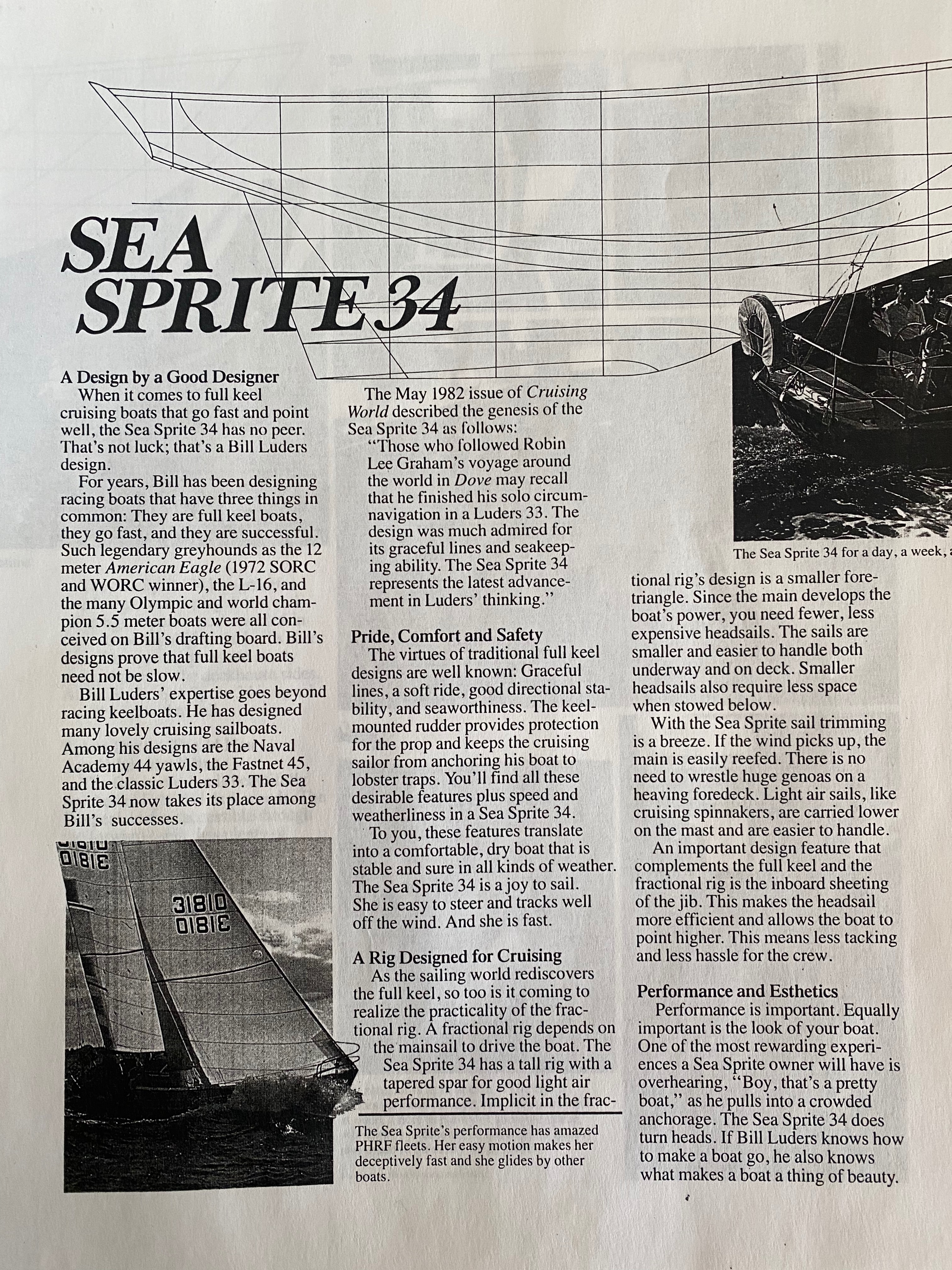
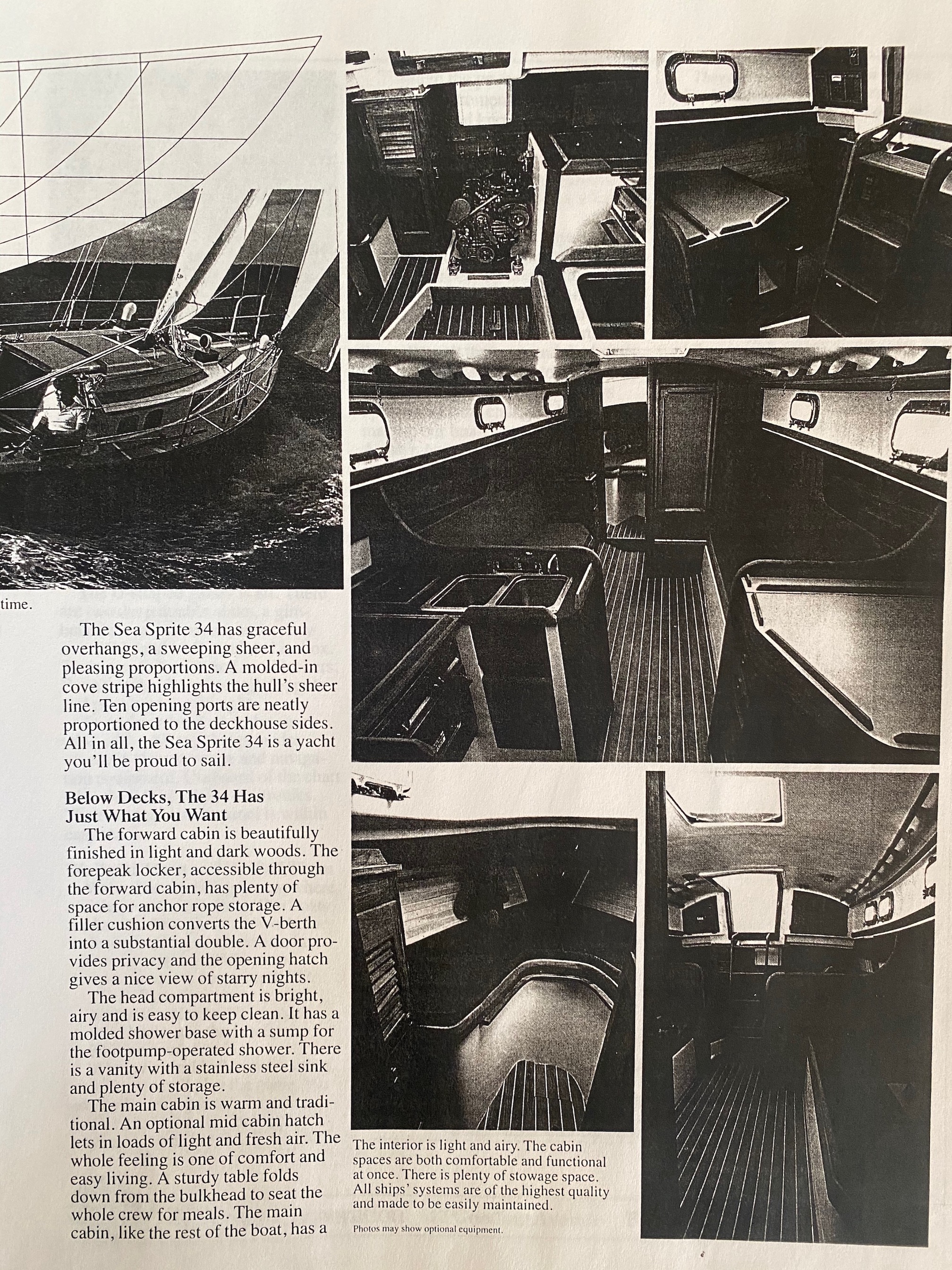
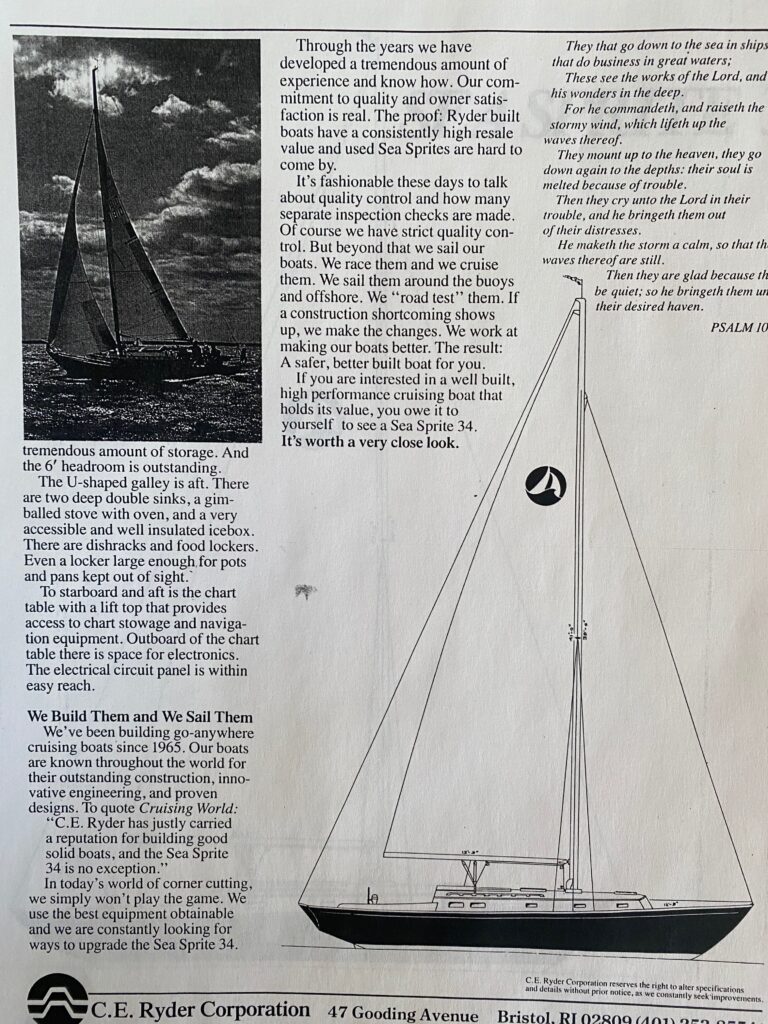
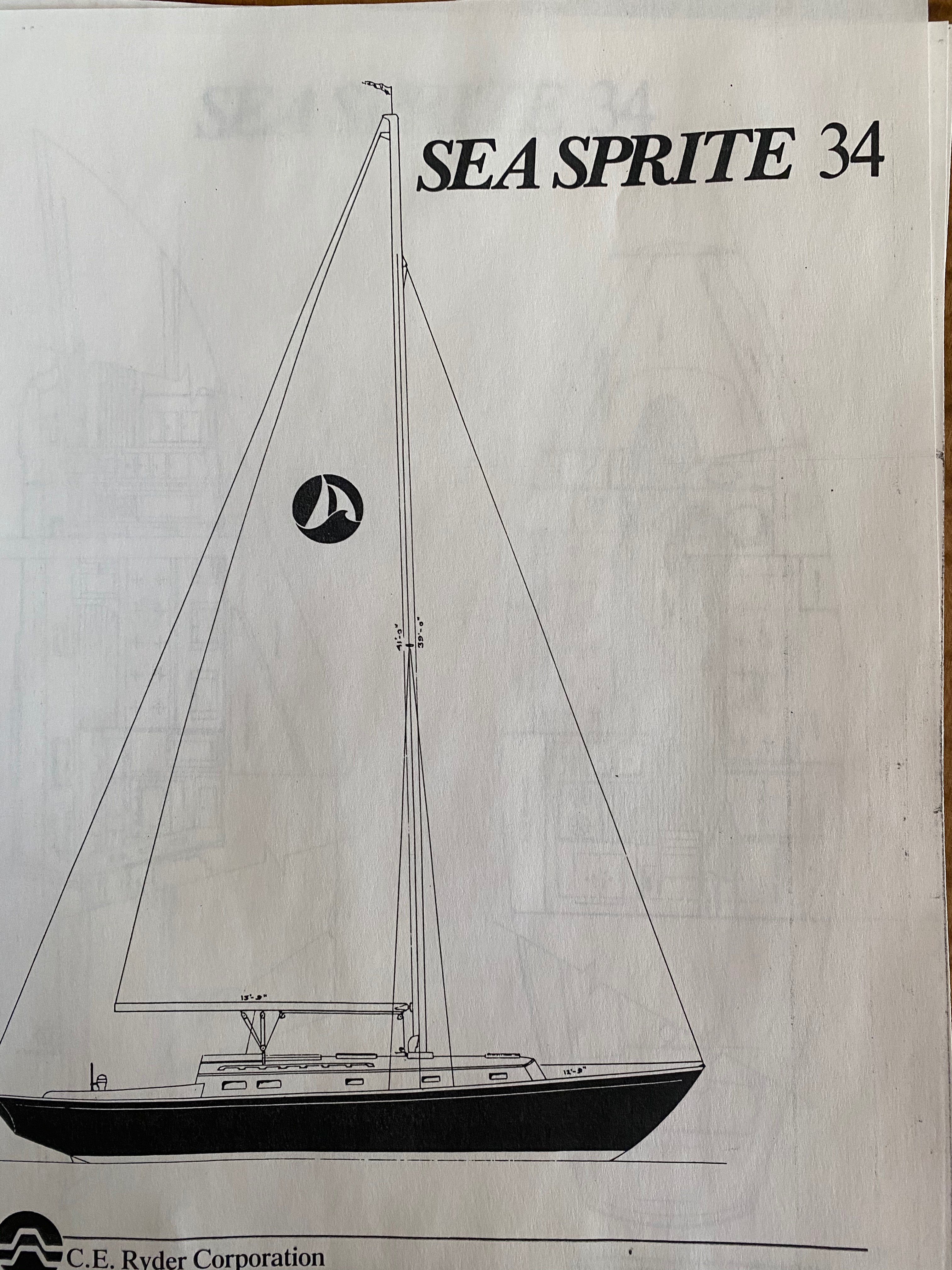

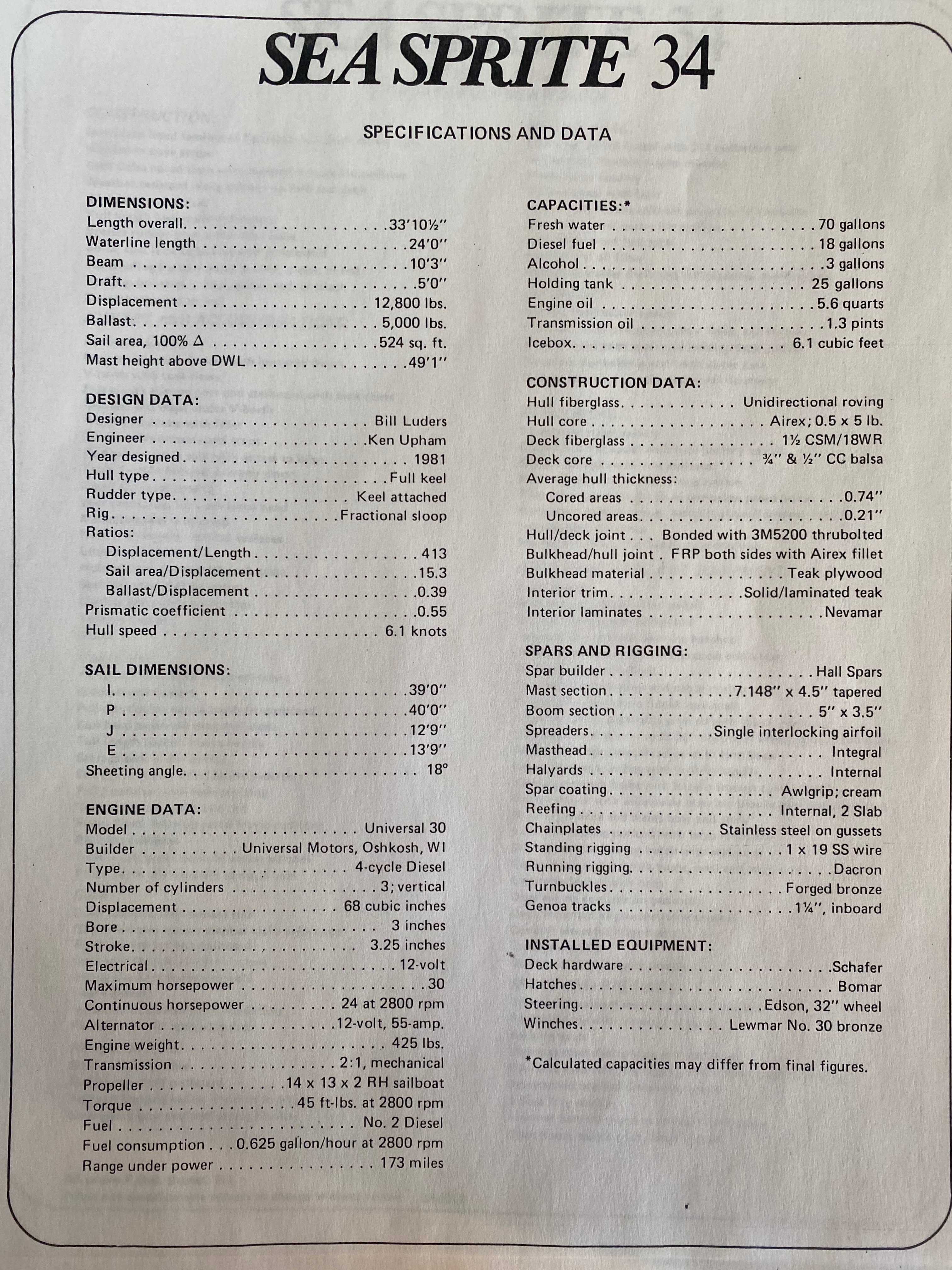
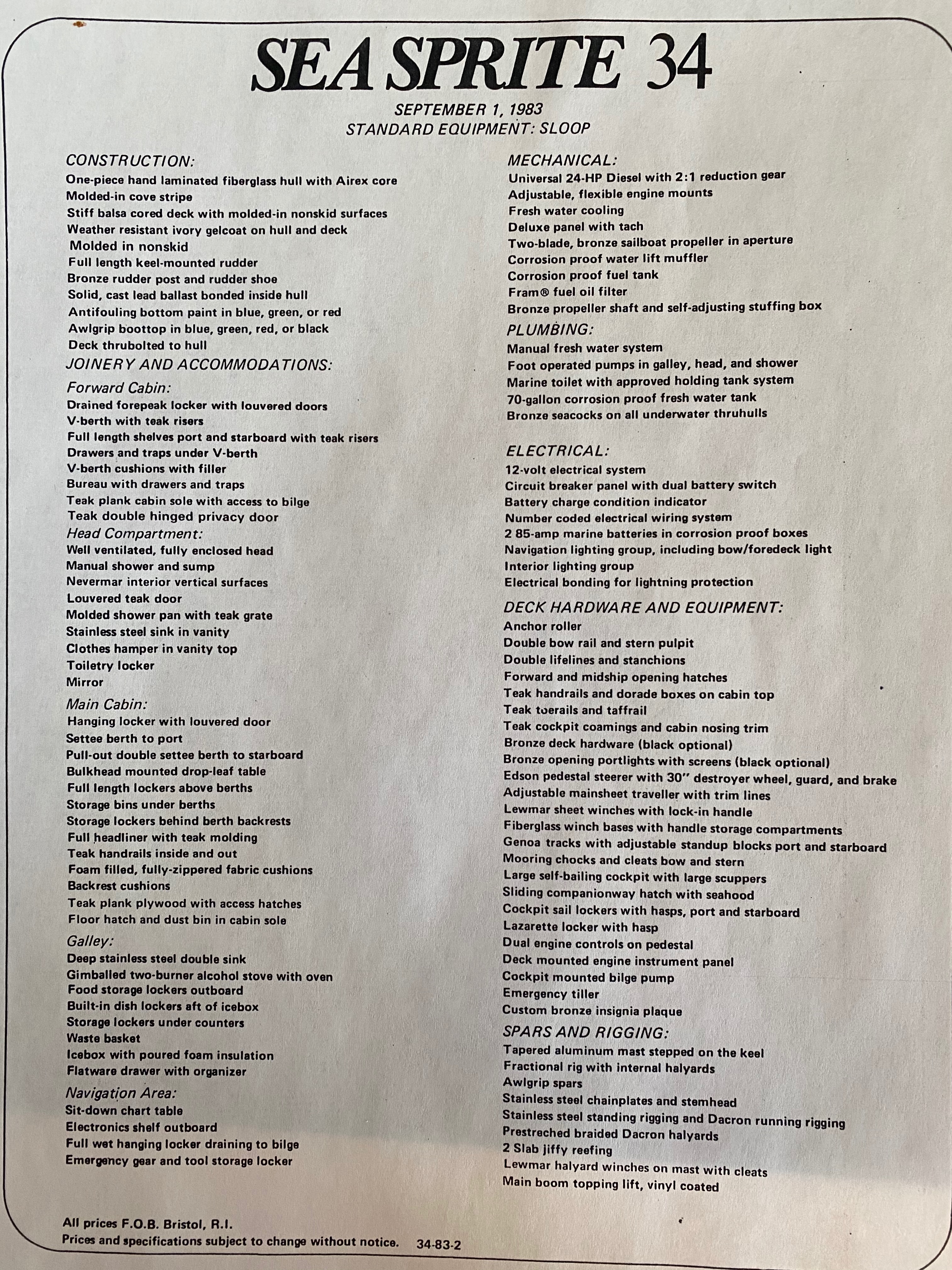
AN ORAL HISTORY CIRCA 2007 FROM THE FORUM
I have copied a thread from the Forum in 2007 led by Robert Gainer and Dennis, an avid SS sailor at that time. Robert Gainor as a young 17 yo sailed a SS23 from Wickford, RI, to Falmouth, ENGLAND. He wrote a book about the trip entitled “Presumed Lost: The Saga of Robert Gainer”. He unfortunately died in 2008, and is remembered fondly:
We mourn the loss of Robert Gainer, a beloved member of The Beacon Institute family and staff. He died unexpectedly at home on Sunday, February 17, 2008.
Bob was a unique man. His kindness and quiet ways belied a deep intellect and diverse talents. As our maritime specialist, he was responsible for the redesign and outfitting of our research vessel, design and deployment of our docks at Beacon Harbor, and troubleshooting the computers and internal network at our 199 Main Street office. On weekends he conducted education programs in boatbuilding and marlinspike seamanship for school children. Bob was to be a key part of our deployment team for the Rivers and Estuaries Observatory Network. He was a navigation expert, accomplished sailor, boat designer and builder, computer whiz, and talented teacher whose special skills made him an instant hit with the young. Bob never lorded his expertise over adults either. Instead he would eagerly use an opportune moment to add to the knowledge of another.
In his early twenties Bob sailed solo across the Atlantic. After a period during which he has out of contact with the world ashore, he was presumed and reported dead. After he turned up alive he was made a guest on the television quiz show “I’ve got a Secret.” Bob was known the world over for his sailing and navigation expertise. Online forums contain beautifully written explanations in Bob’s patient prose where he answers the arcane queries of sailors and others hoping to glean some of his knowledge. But those of us who worked side-by-side with Bob will miss the gentle soul who sought solutions rather than fret over problems, who enjoyed making easier the lives of those around him, and who believed in kindness always. He will be sorely missed.
—John Cronin
Here is the oral history thread:
I’m in the planning stages of changing boats. In past years I’ve owned a Cape Dory 28, Cape Dory 31 and a Vindo 45. Right now I own a Catalina 22. I took a dozen years off from sailing and now sail and will continue to sail on Lake Sunapee in NH instead of the coast of Maine. I love the lines of a good classic boat and 22 – 23 feet is about what I want. I have a retarded and handicapped daughter that my wife and I have been able to figure out how to get her below easily and maintain her securely in the Catalina. I am confident that I can do that with a Sea Sprite. As we are on a lake, and I love wood work I am drawn to the day sailer. The only manufacturer of the daysailer that I’ve seen is sailstar, but on this forum I keep hearing people talk about CE Ryder as the builder of choice. Does it matter? How could I tell? I have a lead on a daysailer how do I tell who built it, and do I really care?
thanks
Jul 07, 2007#2
Charlie,
As far as I know Ryder only built the weekender version. My second Sea Sprite was a weekender built by Sea Sprite in Wickford with Ryder only doing the fiberglass work for the boat and Sea Sprite doing the rest. At that time the weekender was the only model you could buy. My first Sea Sprite was a daysailor and Hope Valley Laminates built her so at least two companies built the daysailor. In any event the daysailor was only built before the now required HIN (hull identification number) was in use so you may not find any thing on the boat that tells you the manufacturer. Your only hope then is the paperwork or the owners recollection.
If you know the sail number you can look at the owners list and contact owners before and after your number to see who built their boats. That might pin it down. I have a list of owners that is more complete then the one available on the web so I might be able to give you some owners names if you let me know the sail number.
As far as the do you care part of the question I think all the daysailors are about the same with some minor variations. The Sailstar boats are the older ones of the family and if my memory is correct they had a tapered mast and problems with the chainplates. The Hope Valley boats had an un-tapered mast but a poor design for the spreader bases. I have only seen a few of the many boats built over the years so the differences I know about may have more do to suppliers then builders.
I think Dennis has a better handle on the variations then I do so it should be interesting to see what he has to say. He also might have a more complete owners list that has boat type information on it.
All the best,
Robert Gainer
Jul 08, 2007#3
Charlie,
No one knows how many builders there actually were. Bobs thread was the first time I heard of Hope Valley Laminates. A little more on the differences between the day sailor and the weekender that may be understood but have not been mentioned: The day sailor does not have a self bailing cockpit. As a result, like an Ensign, you sit much lower in the boat and for that reason it is a much more secure feeling ride. The coamings on the day sailor come up to the shoulder blade versus the small of your back on the weekender. Conversely the weekender has the self bailing cockpit which makes the boat less likely to sink. The self bailing cockpit requires the cockpit deck to be raised higher than the water which explains why the seating is so much higher.
Modifications to the boat: For modifications that you are talking about, I think the Ryder boat is the only one to avoid (I NEVER thought I would be saying that) but the Ryder boats had two fiberglass liners one for the overhead and one for the furniture. It has a Vee berth and quarter berths separated by a sink to starboard and cooler to port. The other liner is the overhead. The liners are one of the things that make the boats desirable but modifications are difficult to do well. On all the weekenders, there are two or three steps down to the cabin sole and the cabin is approximately 4 tall. At 56I could stand on the cabin sole of a Ryder boat and rest my arm on the cabin top.
The older weekenders have wood furniture that is tabbed to the hull making the customizing much easier. Also, the transition to the cabin sole from the cockpit sole on the day sailor is much easier.
One problem I have seen with almost every day sailor is the mast step. When these were built, they were beginning to understand the lower weight and additional strength of cored fiberglass but they did not understand the problems with water intrusion into the core. I have also seen some unique ways to work the step. This is a caution for all the older Sea Sprites, particularly the day sailors. Watch for soft mast steps and soft decks. Also know that these boats are so simple, correcting the problem is not difficult.
Keep us posted and good luck.
Dennis
Dennis,
Can you add to or correct any information in this quick list?
American Boat Building
East Greenwich RI
Started building the Sea Sprite in 1958
Sailstar – Sea Sprite
1 Constitution Ave
Bristol RI 02809
Hope Valley Laminates
Last hull number was 232
Sea Sprite Co.
Wickford Shipyard
125 Steamboat Avenue
Wickford Harbor, North Kingstown R.I. 02852
Last hull number was 486
C. E. Ryder
47 Gooding Avenue
Bristol RI 02809
Hull numbers 500 to 786,
1974 to 1986
Does anybody have a complete list of the sail numbers? And did American really build any of the boats or did they just have the original plans made and Sailstar was the first builder. Chester Rice told me that American built the wooden plug for the first mold but I dont know this to be really true. I have a lot of paperwork in storage about the Sea Sprite and I need to get it organized one day.
All the best,
Robert Gainer
Jul 08, 2007#7
Bob,
While I knew there were more than three builders, the only ones I really knew built boats were Sailstar, WSY and CER.
I knew Ryder started at 500 and finished with 786 which was Chad Martin’s Calamari. I am also pretty sure that some of the Weekenders have the same numbers as the Day Sailors. It makes it impossible to figure out how many were actually built.
Thanks for the info
Dennis
Jul 14, 2007#8
I own hull #579 and the serial number begins with “WSY”–I assume this refers to Wickford Ship Yard. It was built in late 1975 or early 1976. I had always assumed it was Wickford-built, but vaguely remember a post regarding some hulls started by Wickford and completed by Ryder. Just curious if anyone has more information on the transition between Wickford and Ryder.
Thanks
John
Jul 14, 2007#9
John,
Welcome to my world. I spent a couple of years trying to figure it all out. I never did. It would not surprise me if numbers were repeated. Particularly where they were different manufacturers. WYS hull number 001 and CER hull number 001 would make sense but I think they tried to keep the sail numbers unique. Then we get into the other manufacturers that made both the weekender and the day sailor. Did they have day sailor 001 and Weekender 001? I really don’t know. We know that those boats were built before the HIN standards were established so many people have no idea what hull number they have. Was it an IRS dodge? We started the year building hull number 5 and finished with hull number 15 therefore we only built 11 boats while they built three with no number? While I doubt the last scenario, many of the builders lived on the financial hairy edge and no one knows what they really did.
Your HIN starts with WSY it is therefore a WSY boat. Maybe there was overlap on the numbers between Wickford and Rider.
Cheers
Dennis
Jul 14, 2007#10
I dont think it was a case of boats being started by Wickford and being finished by Ryder. In fact it worked the other way. Near the end of Wickfords run the molds were sent to Ryder and he did the glasswork as a contractor and then sent the boats back to Wickford for the woodwork and final assemble. My second Sea Sprite was in that group and was molded by Ryder and built by Sea Sprite in Wickford. Ryder later bought the company and then started building the boats in his shop.
Just before the molds were sent over to Ryder, Wickford had some problems with the gelcoat on the decks having a mottled appearance. I was offered the option of getting one of those decks and saving some money when my boat was scheduled to be built. I opted to pass on that offer and wait until the molds were sent over to Ryder before having my boat built. Another reason to wait for the change was that Ryder made some temporary modifications to the molds so that I could get the deck layout I wanted while Wickford was hesitant to do that. Ryder was also willing to modify the hull deck area in the way of the chainplates and installed the chainplates I had Rigrite make for the trans-Atlantic trip
The day sailor and weekender raced together and I dont recall ever seeing a duplicate sail number. While not proof that tends to support the theory that the numbers were unique between the two types.
All the best,
Robert Gainer